Aurora Expeditions’ Greg Mortimer Ship Review

The Greg Mortimer holds a special place in the world of expedition cruising.
When it launched in 2019 it wasn’t just another polar ship — it was the first passenger vessel built with the groundbreaking Ulstein X-BOW®.
That single innovation changed how travellers experience wild seas, setting a new benchmark for comfort and efficiency in the harshest environments on Earth.
Named after Greg Mortimer, the Australian mountaineer who co-founded Aurora Expeditions, the ship reflects his pioneering spirit.
It’s designed for people who want adventure at the edge of the world, but don’t want to give up the warmth of a comfortable base when they return from the ice.
Over the years we’ve sailed on nine different expedition ships, and toured a bunch more through our jobs as photography guides, and the Greg Mortimer really stood out as something special.
We recently spent 10 days exploring Svalbard in the high Arctic onboard the famous GM, and it surpassed all our expectations.
It feels slightly more stripped back and adventurous compared to Aurora’s newer Sylvia Earle, but it doesn’t skimp on the essentials: smooth sailing, quick Zodiac operations, great food, and cabins that make you feel at home in some of the planet’s most remote corners.
- Read our full Sylvia Earle ship review here.
Over time the Greg Mortimer has built a reputation as one of the most reliable and comfortable ships in the polar regions.
It’s luxurious without being pretentious, well-designed, well-run, and consistently delivers the kind of experiences that make an expedition unforgettable.
So what makes the Greg Mortimer different, and is it the right ship for your Antarctica or Arctic voyage? Let’s take a closer look.
Special Note: Jarryd will be working onboard the Greg Mortimer for two months in the upcoming Antarctic season as the Expedition Photography Guide. If you’d like to join him drop us a message as we have a special offer we can give to NOMADasaurus readers for any Aurora Expeditions itinerary (whether we’re onboard or not)!
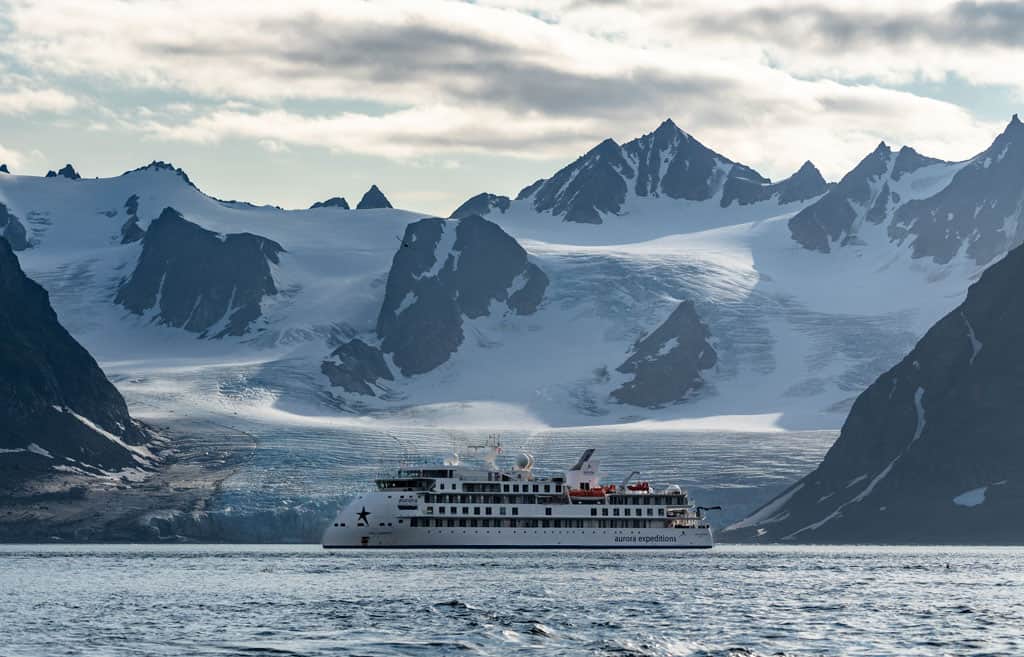
- World-first design – The Greg Mortimer was the first passenger ship to feature the Ulstein X-BOW®, cutting through swells instead of slamming over them. The result is a smoother ride, improved fuel efficiency, and less seasickness.
- Drop-down viewing wings – Unique fold-out platforms extend from the bow, giving guests jaw-dropping views just above the waterline. Perfect for wildlife watching, iceberg photography, or simply soaking in the silence.
- Capacity of 130 passengers – Small enough to feel personal, large enough to offer multiple landing rotations. Even though the ship can carry 160 passengers, Aurora Expeditions has made the decision to limit numbers to 130 maximum. With IAATO rules limiting shore visits to 100 people at a time, Aurora ensures smooth, fair systems so everyone gets maximum time ashore.
- Dining setup – The ship’s main restaurant serves buffet-style breakfasts and lunches with à la carte dinners. A second option, the Tuscan Grill, can be booked for a more intimate dining experience in the evenings.
- Cabin variety – From spacious staterooms to balcony suites and the impressive Captain’s Suite, the Greg Mortimer caters to a wide range of budgets and preferences.
- Efficient mudroom and Zodiac ops – Large gear lockers and multiple boarding points make excursions quick, safe, and stress-free.
- Adventure-focused – Unlike the Sylvia Earle, the Greg Mortimer does not have a Citizen Science Lab. Instead, the emphasis is squarely on classic expedition cruising — landings, Zodiac tours, and off-ship adventure activities like kayaking or camping.
- Wellness and comfort – A gym, sauna, hot tubs, and new transparent domes on the outer decks offer welcome relaxation after long days in the field.
- Leading cruise line – Aurora Expeditions is recognised as one of the leading cruise lines for polar exploration, with a strong reputation among all companies operating in Antarctica and the Arctic.
READ MORE: Check out our complete guide to the best Antarctica expedition cruise companies!
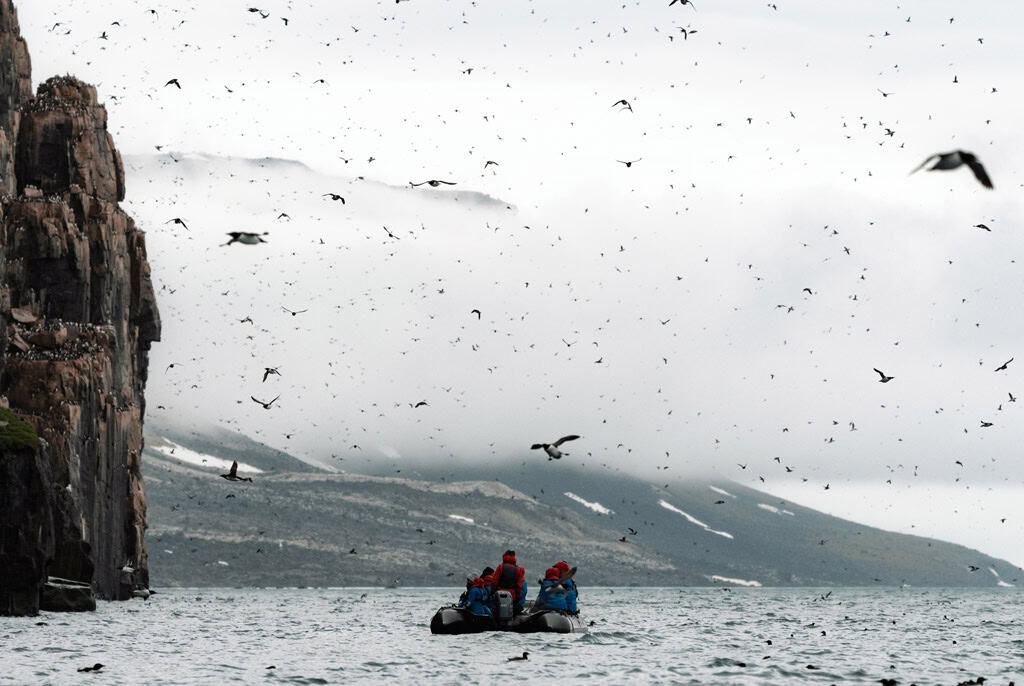
Aurora Expeditions is an Australian-owned company that has been running small-group adventure voyages since 1991.
Founded by the legendary mountaineer Greg Mortimer and his wife Margaret, the company quickly became known for pushing boundaries in expedition travel.
Their first trip to Antarctica in 1992 set a precedent, combining scientific curiosity with hands-on exploration.
Aurora was among the founding members of the International Association of Antarctica Tour Operators (IAATO), and they’ve built a reputation for being both pioneering and responsible.
Over the years, they introduced new activities to the polar cruising world, including the first commercial climbing trips in Antarctica back in 1995.
Today, Aurora operates two purpose-built polar vessels: the Greg Mortimer (2019) and the Sylvia Earle (2022).
A third ship, the Douglas Mawson, will be launching in 2025.
With these, Aurora continues its tradition of offering immersive, low-impact travel experiences to some of the most remote corners of the globe — from Antarctica and the Arctic to Patagonia, Costa Rica, and the British Isles.
Aurora’s voyages reach almost every continent, but their specialty remains the wild, hard-to-reach places.
From Antarctica to the Arctic, their itineraries are designed for travellers who value time in the field over ticking off destinations.
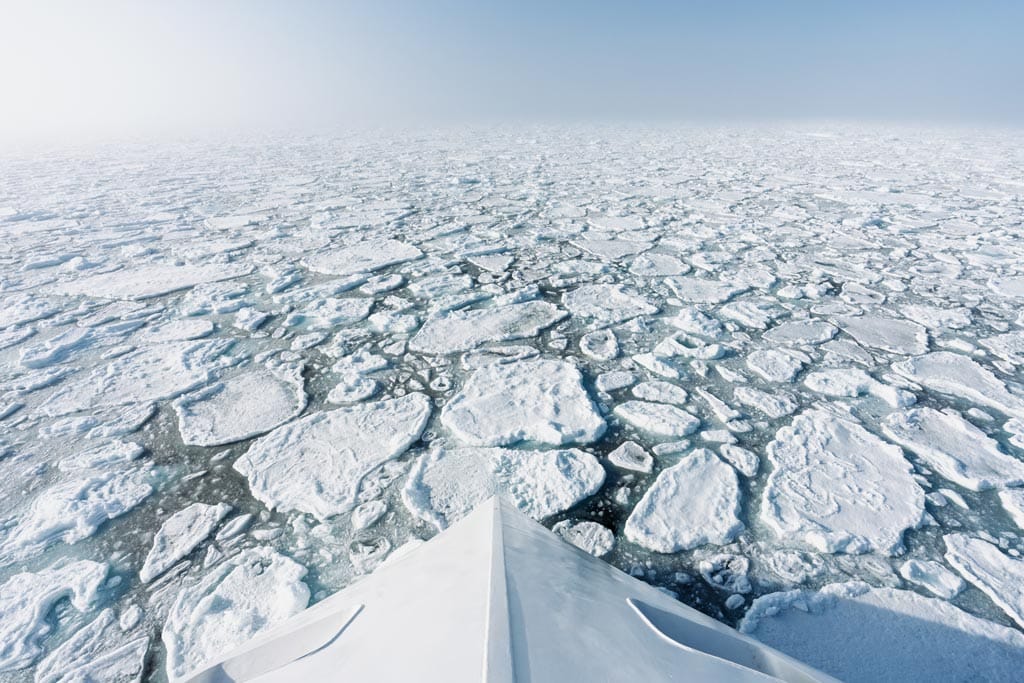
The Greg Mortimer is a vessel built for explorers. At 104 metres long with a capacity of just 130 passengers, it’s large enough to offer modern amenities while remaining intimate and expedition-focused.
Unlike traditional cruise ships, everything about the Greg Mortimer is designed to maximise time in the field.
The Zodiac loading points (two on the port side, two on the starboard side and the large marina deck on the rear) make boarding fast and safe.
The mudroom is spacious and efficient, and the drop-down hydraulic wings create a front-row seat to the polar wilderness.
Inside guests will find comfortable cabins, a welcoming main restaurant, a small grill for specialty dining, a lecture theatre, lounges, a gym, sauna, Jacuzzis, and even new domes to to enjoy the views without being affected by the elements.
The ship also features a dedicated observation deck, providing panoramic views of the surrounding polar landscapes. Even though it’s luxurious, it’s about providing the perfect base between adventures.
The ship was the first passenger vessel in the world to feature the Ulstein X-BOW®, a wave-piercing hull design that improves stability and reduces slamming in heavy seas.
his is particularly important in notorious stretches like the Drake Passage, where a smoother ride makes all the difference.
Travellers might ask: should I choose the Greg Mortimer or the Sylvia Earle? Both ships are modern, eco-conscious, and purpose-built for polar exploration, but they offer slightly different onboard experiences.
| Feature | Greg Mortimer | Sylvia Earle |
|---|---|---|
| Launched | 2019 | 2022 |
| Passenger Capacity | 130 | 130 |
| Citizen Science Lab | ❌ No | ✅ Yes |
| Dining | Main restaurant + Tuscan Grill | Gentoo Restaurant + Rockhopper Restaurant |
| Atmosphere | Slightly more adventure-focused, streamlined design | Slightly more modern, with expanded social/educational spaces |
| Key Differences | Drop-down hydraulic wings | Glass atrium at bow |
Our take: Both ships are truly special, and choosing one or the other really does come down to essentially which itinerary you want on what dates.
However if you want a ship that feels a bit more rugged and pioneering, go with the Greg Mortimer. If you prefer a vessel with more scientific and educational facilities, the Sylvia Earle edges ahead. Either way, both deliver a world-class polar expedition.
-
This Sylvia Earle ship review gives you a full rundown on what to expect from this eco-friendly, state-of-the-art expedition vessel by Aurora Expeditions. Find out about its key features and onboard experiences right here.
-
Curious about Aurora Expeditions’ first X-BOW vessel? In our Greg Mortimer ship review we reveal the highlights, quirks & adventures from onboard.
-
From the Great Barrier Reef to the lush rainforests to the sunburnt Outback, here are the best places to visit in Queensland. Queensland is Australia’s sun-soaked playground, brimming with natural … Read more
READ MORE: Our full guide on Antarctica vs the Arctic is now live! Check it out to help you make your choice for your next polar adventure.

Life on an expedition ship shouldn’t be about ornate chandeliers or sprawling penthouses. What matters most is having a warm, comfortable space to call your own after a day out among glaciers and polar bears.
While some companies prioritise the onboard experience, where you need to get dressed up for meals and the hotel staff are the stars of the show, Aurora Expeditions and their Greg Mortimer ship has found the balance between offering a luxury base while making the guest feel at home.
With just 76 staterooms, the ship feels personal and unhurried.
Every cabin comes with an ensuite, storage for bulky gear, and large windows, or in most cases private balconies, that keep you connected to the outside world even when you’re indoors.
The design is simple but smart: functional, uncluttered, and built for travellers who value exploration over extravagance.
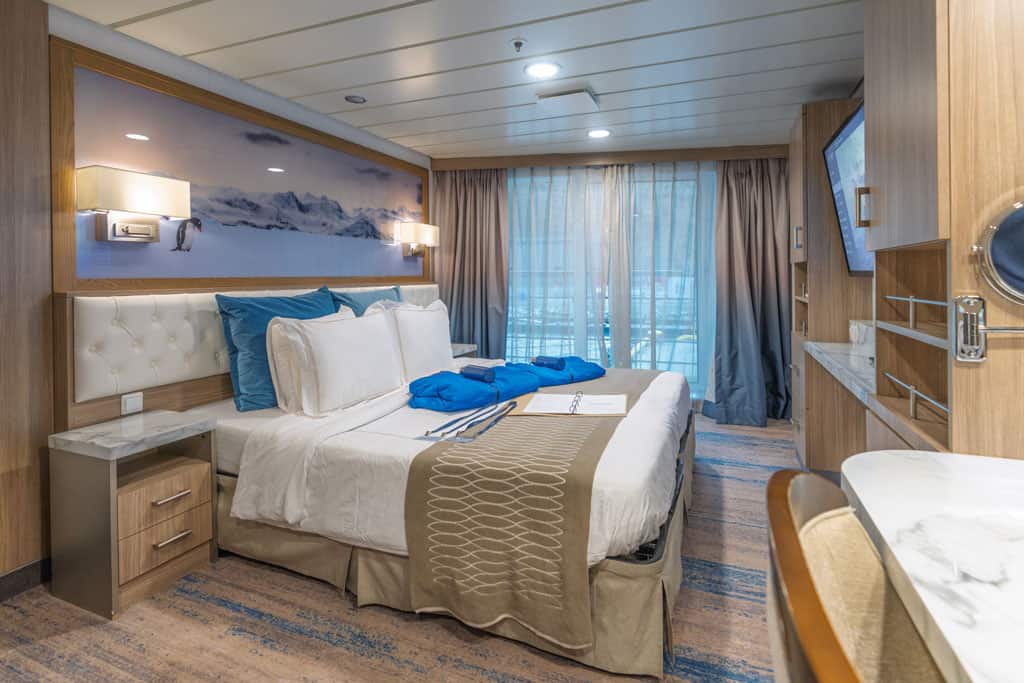
During our voyage we stayed in a Balcony Stateroom, and it hovered seamlessly between comfort and practicality.
The private balcony became our morning ritual spot – Stepping outside as soon as we’d wake to check the weather, watch seabirds skim the waves, admire the views, and enjoy a quiet moment as sea ice drifted by.
Inside the room had everything we needed without wasted space. A king bed (that could split into twins), a small lounge corner, and enough storage to keep jackets and camera gear organised.
The bathroom was compact but well designed, with good water pressure, space to move around and even heated floors.
Electrical outlets are universal, so we could plug our Australian chargers directly into the wall without the need for an adaptor.
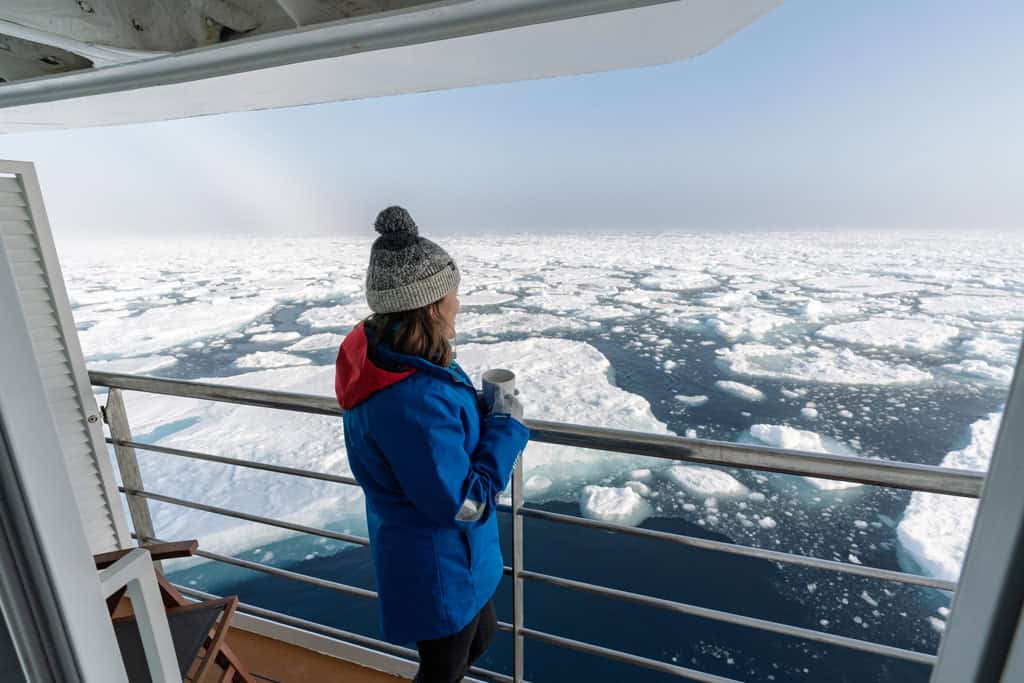
- Aurora Staterooms (Twin/Triple/Single) – The most affordable option, with portholes or large windows. Perfect for travellers who just need a cozy base.
- Balcony Staterooms – Spacious cabins with private outdoor seating, available in different configurations.
- Junior Suites – A step up in size and finish, with a larger living space, more storage, and priority services.
- Captain’s Suite – The most exclusive cabin onboard, with separate bedroom and lounge areas, plus the best balcony on the ship.
No matter which cabin you choose, the focus is the same: a quiet, comfortable place to unwind, with the polar wilderness always within sight.
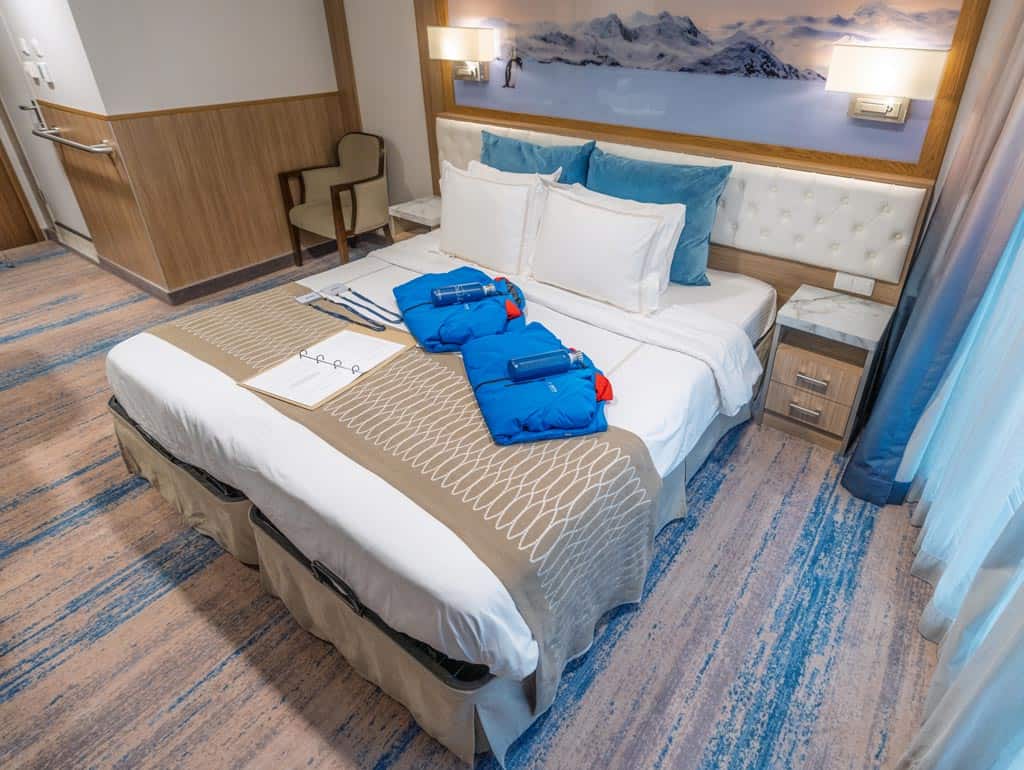
Expedition ships spend plenty of time at sea, so the places where guests gather, learn, and relax matter just as much as the cabins.
The Greg Mortimer keeps things simple but smart, with welcoming lounges, an impressive lecture theatre, and a few unique design elements that make the experience stand out.
Life at sea on the Greg Mortimer is surprisingly social. Between lectures, casual chats in the lounge, and spontaneous wildlife sightings from the deck, the days flow naturally.
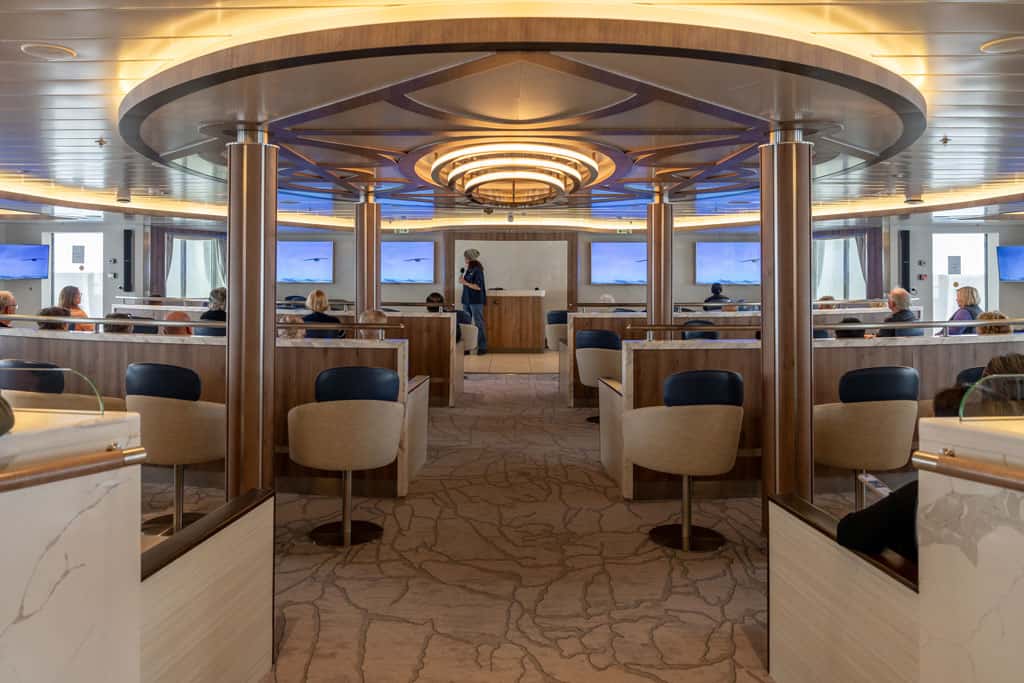
Every evening and many afternoons are centred around the ship’s Lecture Theatre, a comfortable space designed for daily briefings, science talks, and guest presentations.
The layout is straightforward; tiered seating, a large screen, and high-quality AV systems, ensuring everyone has a clear view.
The expedition leader, along with the rest of the team, brings a wealth of knowledge and ensures each session is both informative and engaging.
This is where the expedition guides share their knowledge: marine biology, glaciology, polar history, and practical information about the next landing.
It’s the intellectual heart of the voyage, and the talks are as engaging as the adventures outside.
For those who prefer a quieter evening, most sessions are also streamed to cabin TVs.
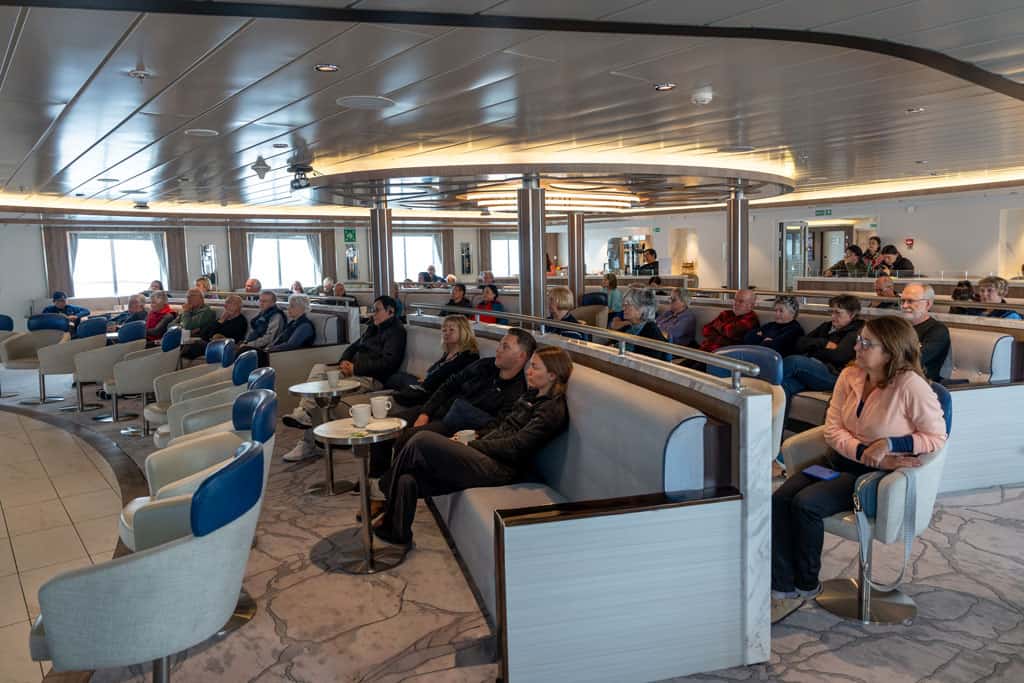
On Deck 8 you’ll find the Observation Lounge, one of the ship’s most inviting spaces. With panoramic windows wrapping almost the entire room, it’s the perfect place to sip coffee while scanning the horizon for whales, or to unwind with a glass of wine in the evenings.
The adjoining bar quickly becomes the social hub after dinner, with bartenders remembering names and favourite drinks, and expedition guides often mingling with guests.
This would be our first point of call on early mornings, where we’d grab a coffee from the barista machine and then hit the decks with binos in hand to search for wildlife.
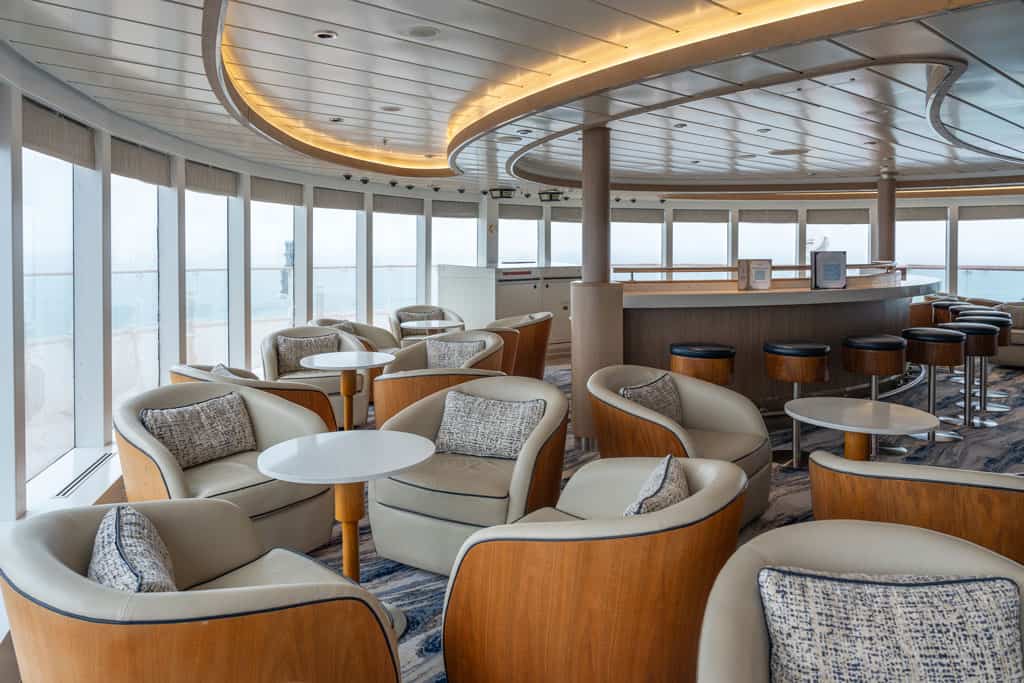
Just because you’re travelling to the most remote corners of the planet doesn’t mean meals should feel like an afterthought.
Meals are something to look forward to after a long day in the elements. The galley team does a remarkable job given the remoteness, serving food that’s hearty, fresh, and satisfying.
The Greg Mortimer has two main dining options: a relaxed main restaurant where everyone gathers for daily meals, and a more intimate Tuscan Grill that you can book for something special.
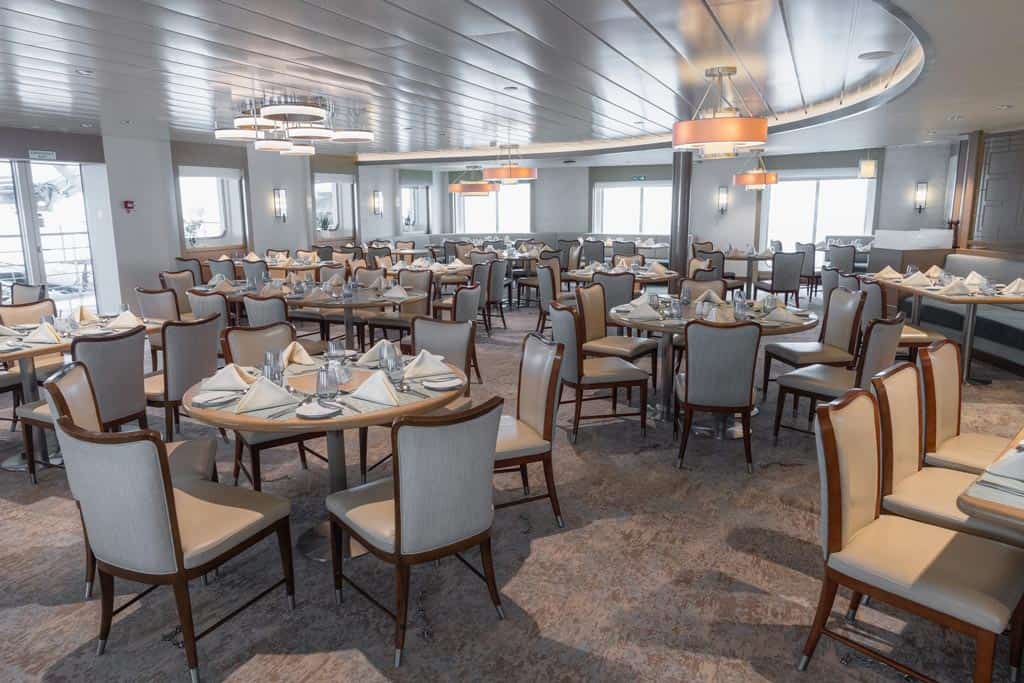
The main restaurant is the ship’s culinary centrepiece, serving buffet breakfasts and lunches before transitioning to full table service at dinner.
Floor-to-ceiling windows line the walls, so every meal comes with a view – whether that’s icebergs drifting past in the Antarctic Peninsula or seabirds wheeling over the Svalbard coastline.
Breakfast is casual and plentiful, with made-to-order eggs, fresh fruit, pastries, and a rotation of hot dishes. Lunch follows the same style, with salads, soups, and international flavours that keep things varied and satisfying.
In the evenings the atmosphere shifts to a more formal feel, with multi-course à la carte dinners.
Menus always include meat, seafood, and vegetarian options, with a few staples (like steak and pasta) available every night.
Wine, beer, and soft drinks are included with dinner, making it a relaxed but refined way to end the day.






For a smaller, more exclusive setting, guests can book into the Tuscan Grill, a specialty venue adjacent to the main restaurant.
It’s a cosy spot with limited seating, so reservations are required.
Meals at the Tuscan Grill are thoughtfully presented in several courses, enhancing the overall dining experience.
The menu is a little more specialised here – think fresh seafood, grilled meats, and chef’s specials that change throughout the season.
Highly recommend the calamari and lamb chops!
Dining at the Grill feels less like a group expedition meal and more like a private dinner party, perfect if you’re celebrating a special occasion or simply want a quieter evening.
As a bonus tip feel free to invite one of the expedition guides who you might be getting along with. While the guides eat in the main restaurant every night, they can only dine in at the Tuscan Grill when invited by a guest.
It’s something they’ll really appreciate, and it’s a great way to connect with the team at a deeper level.

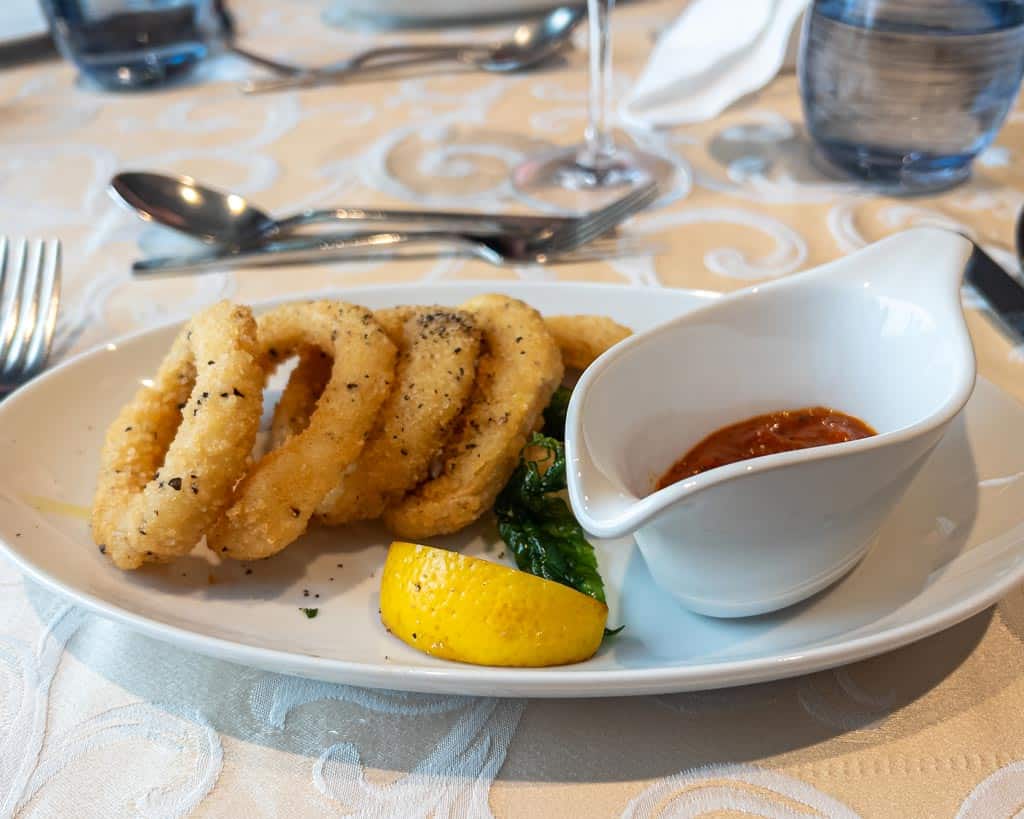
Considering the logistical challenge of serving fresh, varied meals in the Arctic and Antarctica, the Greg Mortimer’s galley team does an impressive job.
Dishes lean toward hearty and nourishing, designed to keep energy levels up for long expedition days.
The service is warm and personal, with staff remembering names and preferences quickly. By the second day you’ll likely have a favourite server who knows how you take your coffee or which dessert you’re waiting for.
The overall atmosphere is relaxed and welcoming, more expedition-focused than luxurious, but consistently enjoyable.
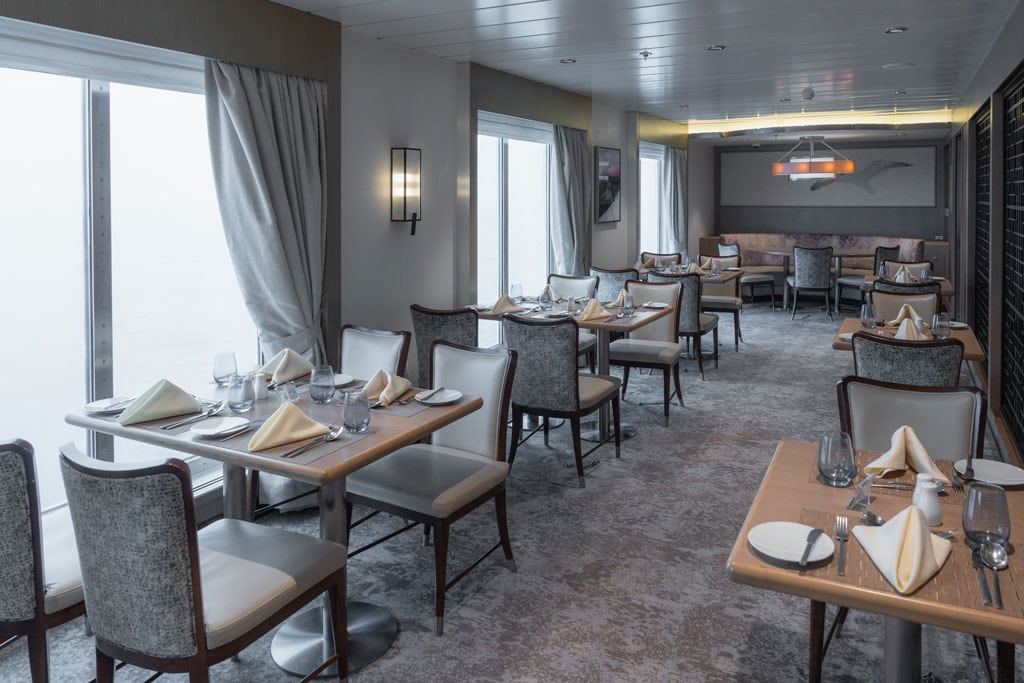
The Greg Mortimer was purpose-built for expedition cruising, and nowhere is that more obvious than in its off-ship logistics.
Every element of its design is geared toward maximising time in the field – whether that means launching Zodiacs quickly, making boarding safe in rough seas, or storing gear efficiently so guests can focus on the adventure rather than the hassle.
We’ve travelled on more expedition vessels than most, and believe us when we say that zodiac operations aren’t always seamless.
One ship in particular that we worked on (that shall remain nameless) would take up to 45 minutes to get all the zodiacs on and off the ship.
Compare that to the Greg Mortimer, which can have all zodiacs on the water in around 15 minutes, and you understand just how much more time you will have for adventures when doing multiple excursions a day.
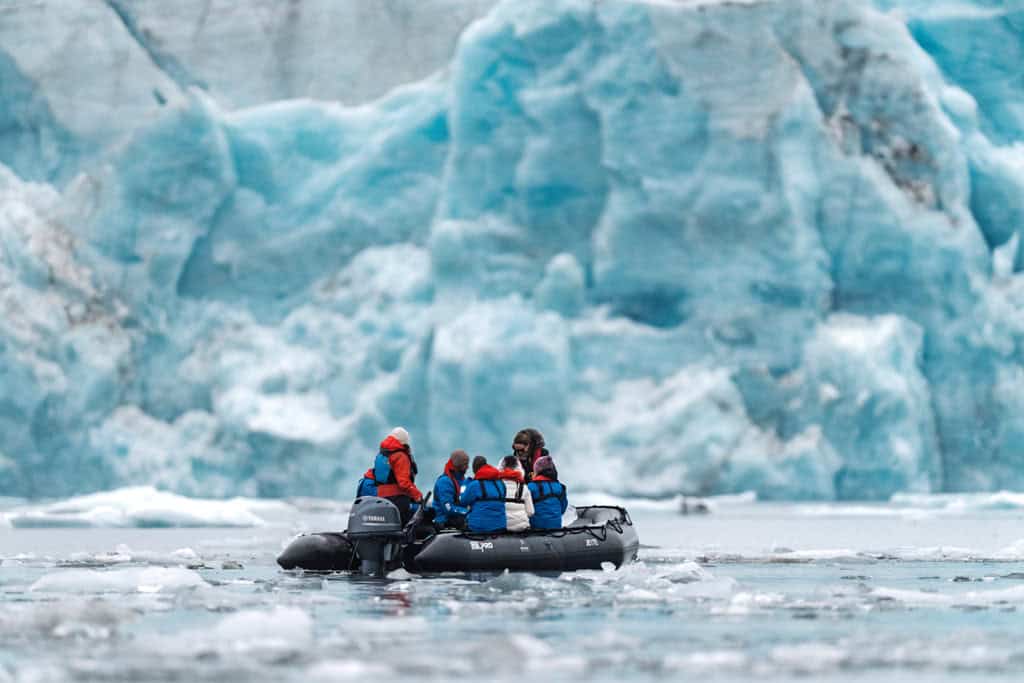
The mudroom, located on Deck 3, is where every excursion begins and ends.
Each cabin is assigned its own dedicated locker for wet-weather gear, boots, and lifejackets.
Having a personal space for your expedition equipment is more than just a convenience – it’s essential to keeping cabins clean and dry, and it makes the turnaround time between excursions incredibly efficient.
Benches line the room so guests can sit to put on boots and layers, while wide aisles reduce the bottlenecks that are common on older ships.
At the exits biosecurity is taken seriously, with boot-wash stations and sanitisation points ensuring no snow, seeds, or foreign matter are carried between ecosystems.
It’s not glamorous, but it’s a vital part of expedition cruising, and the Greg Mortimer does it well.
*When you book a polar trip with Aurora Expeditions a waterproof outer layer, down jacket, waterproof/insulated muck boots and a PFD are included.
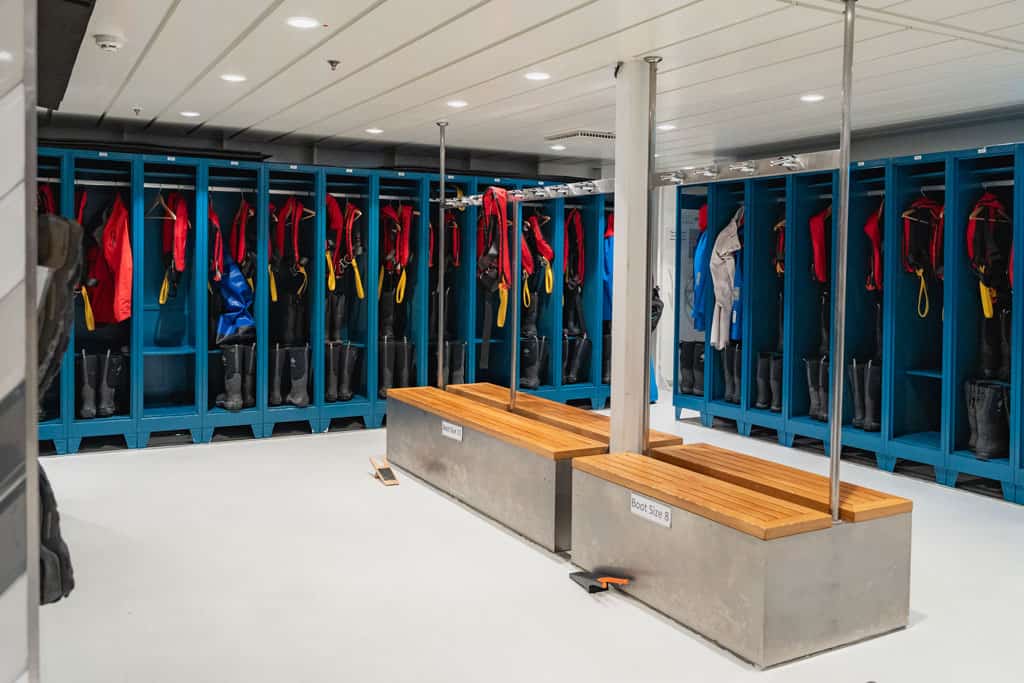

At the stern you’ll find the marina deck, one of the most practical innovations on board.
This wide, low-level platform sits just above the waterline, creating a stable staging area for Zodiacs and kayaks.
When conditions are calm two boats can be loaded at the same time, which keeps operations moving fast and minimises waiting around in heavy gear.
For paddlers, the marina deck is a game-changer.
Instead of clambering awkwardly into kayaks in rolling swells, the flat surface allows for smooth, controlled launches and recoveries.
Guests step into the craft at deck height and are gently pushed off into the water, making the whole process far safer and more enjoyable.
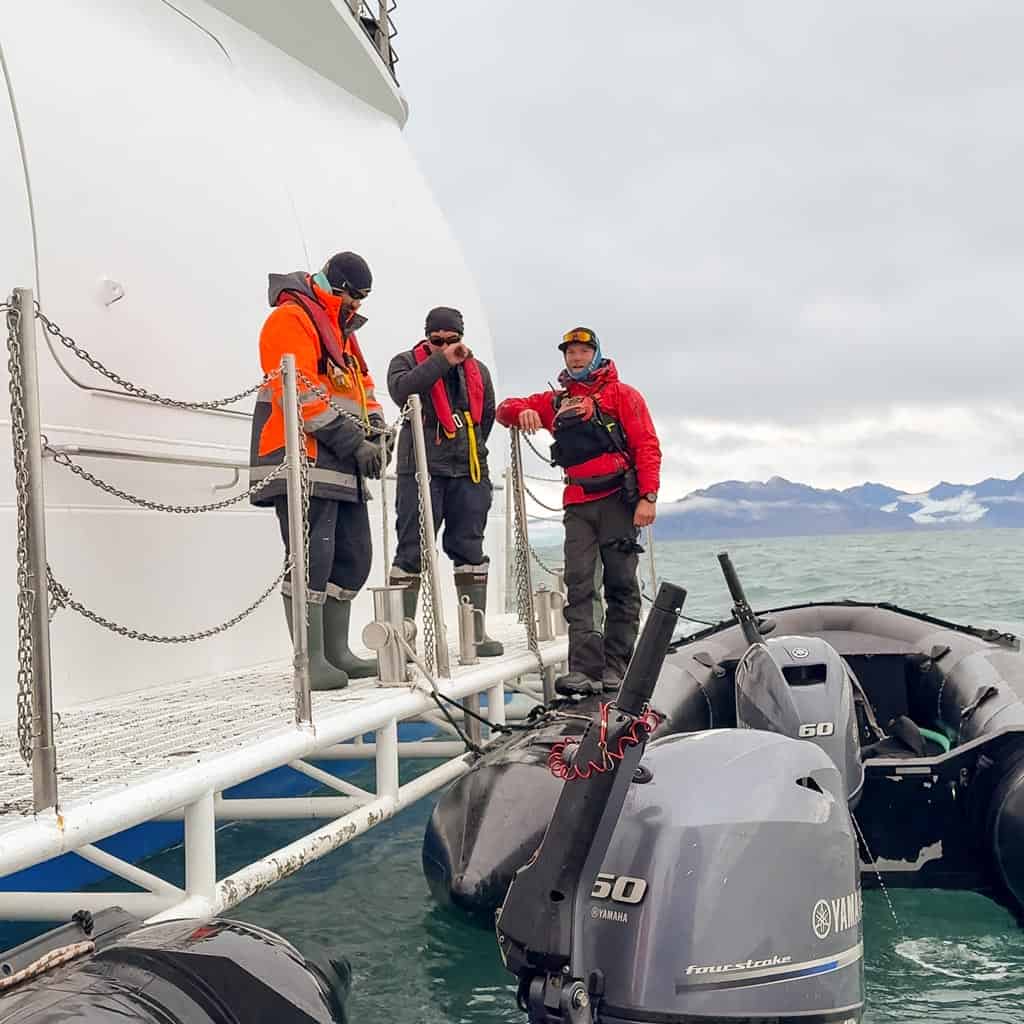
Most landings though are handled through the two port or starboard boarding platforms, with one side used at a time depending on which direction the wind and swell is coming from.
Guests descend interior stairways sheltered from the weather until they reach pontoon level, where the Zodiacs are held steady alongside the ship.
Sailors and guides assist passengers getting in and out of the Zodiacs with a firm sailor’s grip, making the step across straightforward even in lumpy conditions.
This design eliminates the slippery gangways used on older ships, significantly reducing the risk of falls.
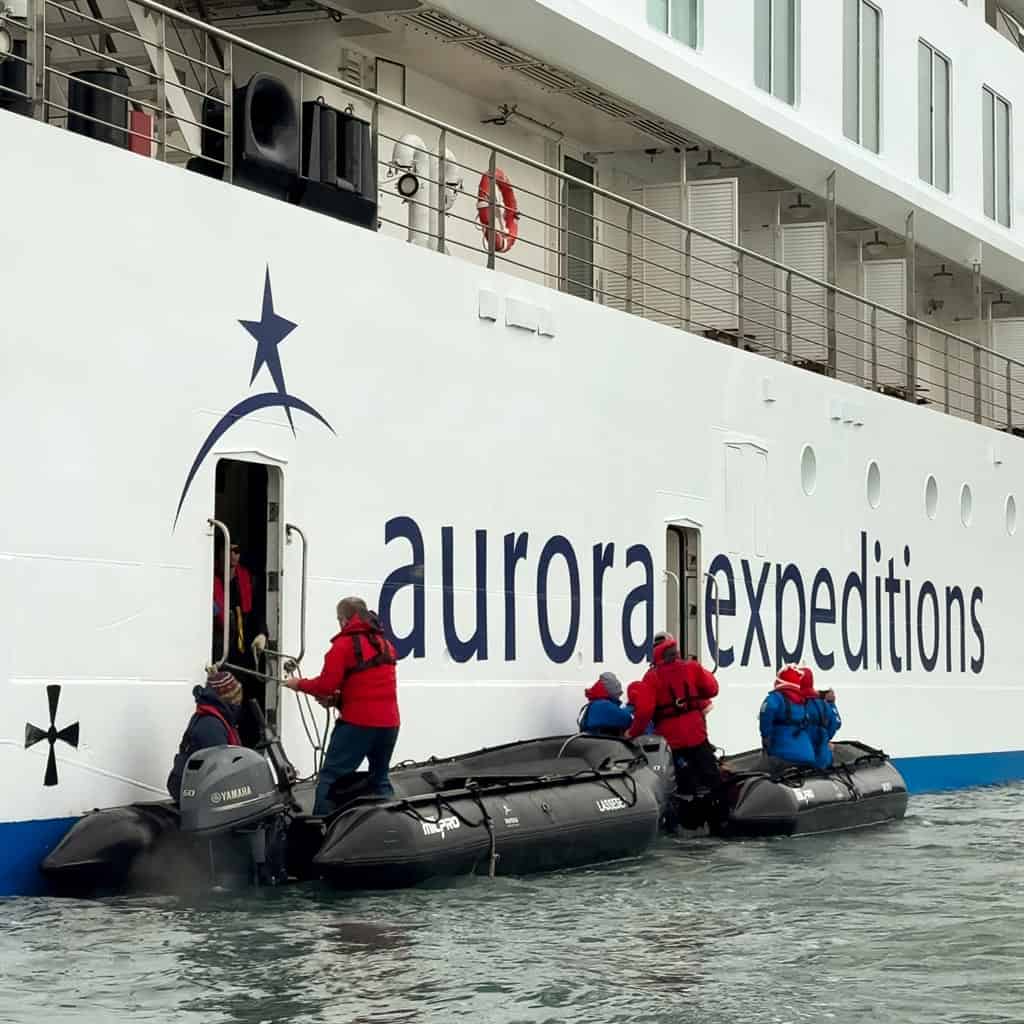
Once the boats are on the water the real adventure begins.
Zodiacs are the workhorses of polar exploration, and Aurora carries enough to keep the schedule flexible and efficient without overloading them.
Scenic cruises through iceberg fields, whale-watching runs, and wet landings on remote beaches all form part of the routine.
Because the Greg Mortimer carries a maximum of 130 passengers, almost everyone can land in Antarctica at the same time.
his is a huge advantage under IAATO regulations, which cap the number of visitors at any one site to 100.
With kayakers and paddlers out in smaller groups, it means no one is left waiting onboard while others explore.
The end result is more time in the field, less queuing on deck, and a smoother overall experience – exactly what you want from a purpose-built expedition ship.
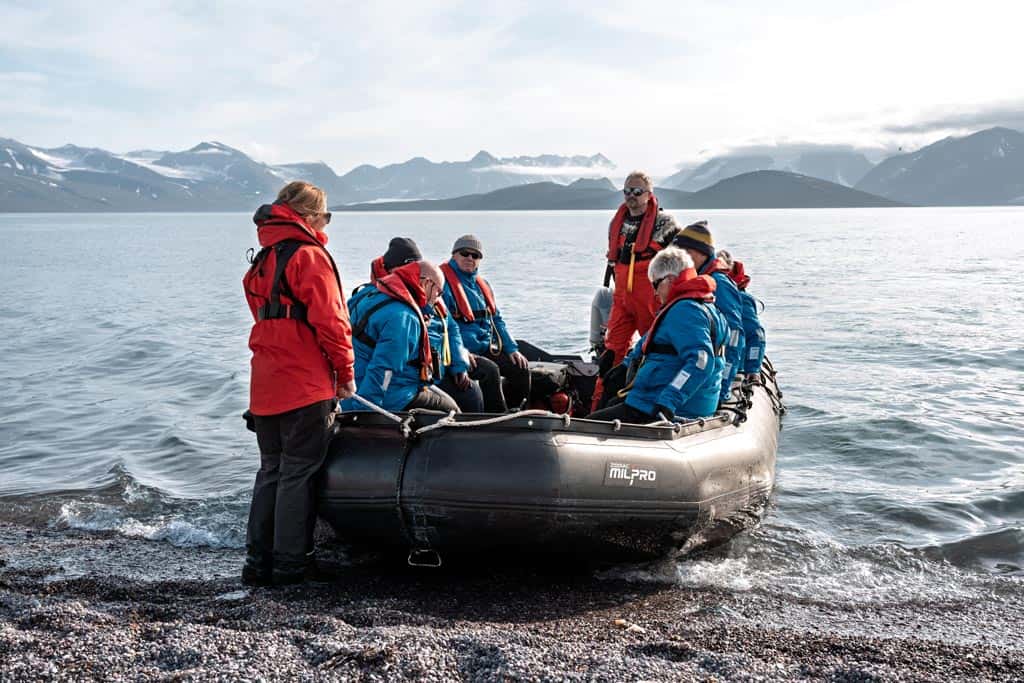
One of the biggest joys of expedition cruising is simply being outside, breathing in the crisp polar air, watching seabirds glide overhead, or spotting whales surfacing in the distance.
The Greg Mortimer was designed with outdoor viewing in mind, and it offers a variety of decks and platforms where guests can connect with the landscapes in different ways.
Out on deck it’s all about the open air, magnificent landscapes and the wildlife.
Guides are often outside with binoculars to point out a distant polar bear or a petrel circling the bow, like you’ve been given front-row seats to nature.
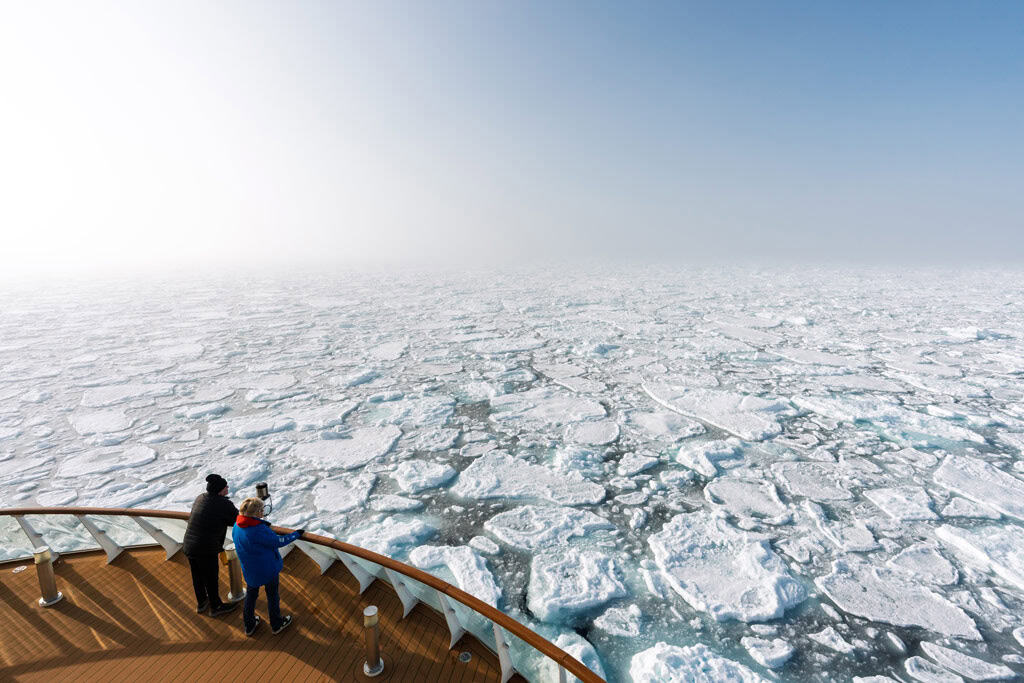
The highest open deck on the ship is Deck 8, which wraps around the Observation Lounge.
Elevated high above the waterline, it provides a wide-angle perspective across the horizon.
This is the place to be during dramatic sail-throughs like the Lemaire Channel in Antarctica or when approaching the rugged coastlines of Svalbard.
Because the deck connects directly to the lounge, it’s easy to dash outside with a camera when the expedition team announces a surprise sighting.
The railings are thoughtfully positioned so photographers can rest long lenses without obstruction, a detail that makes a big difference during long days of wildlife watching.
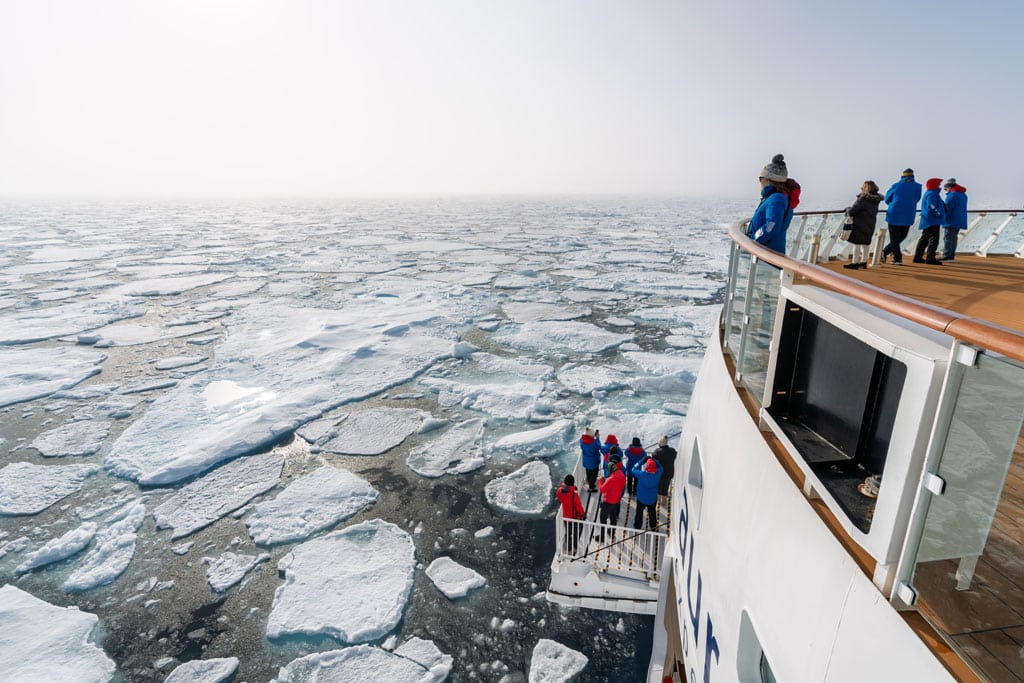
Just below, Deck 7 features two hot tubs. While it might sound indulgent, soaking in warm water while watching glaciers drift by is one of the most memorable experiences you can have on an expedition ship.
Guests often gather here in the late afternoons or after the polar plunge, swapping stories from the day’s landings with a glass of champagne in hand.
The surrounding deck space is also excellent for wildlife viewing. Being slightly lower than Deck 8, it offers a closer angle to the water – perfect for photographing penguins porpoising through the surf or seals lounging on ice floes.
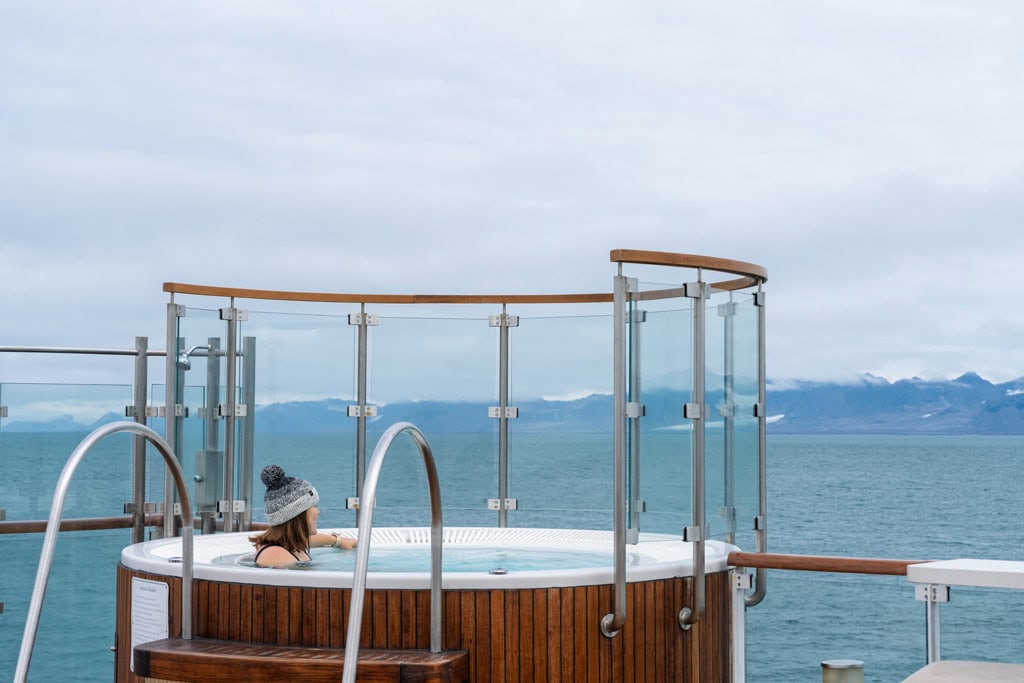
New to the Greg Mortimer are two transparent “igloo” domes located on deck 6.
By day they offer immersive 360° views of the seascape and wildlife; by night, when darkness falls, they transform into serene cocoons where you can settle in with a hot drink and watch the midnight sun, Aurora Borealis or constellations dance across the polar sky.
The gentle hum of the ship below combined with cozy lighting and plush seating, makes these igloos one of the most memorable hideaways onboard.
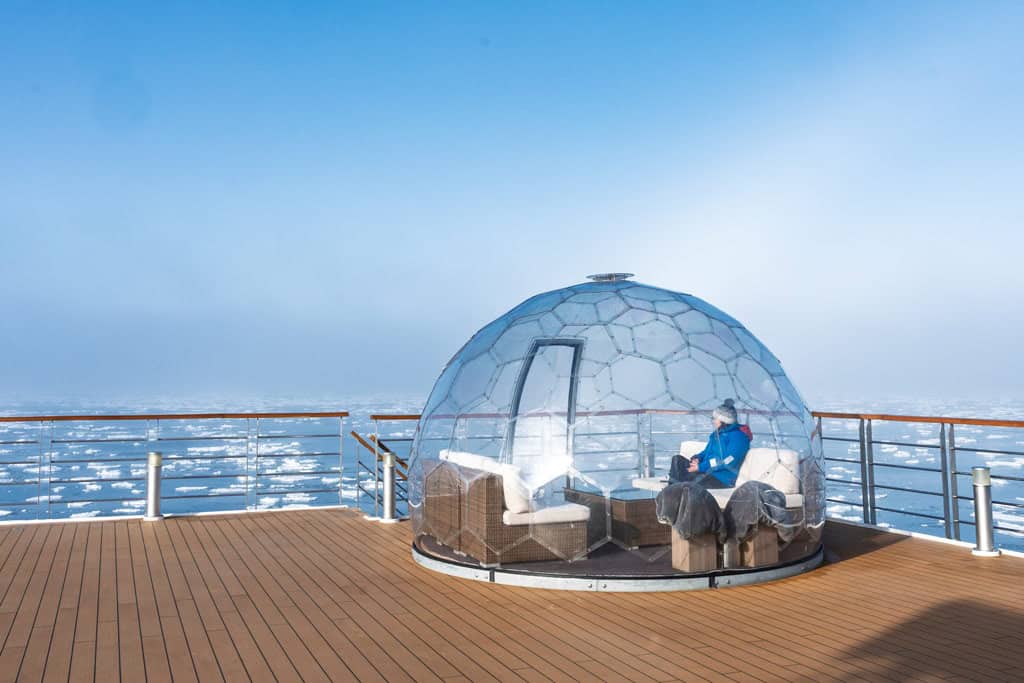
For more immediate access to the outdoors, Deck 4 and the stern of Deck 6 are ideal. These lower-level viewing areas put guests closer to the waterline, giving a different perspective for photography.
Deck 4 in particular is a favourite among photographers, as it provides a stable, less windy location to capture images of whales surfacing or seabirds skimming the waves.
The stern on Deck 6 is another popular gathering place, especially during crossings when albatross and petrels follow the ship’s wake.
With quick access from cabins, it’s easy to step outside at a moment’s notice when wildlife is spotted.
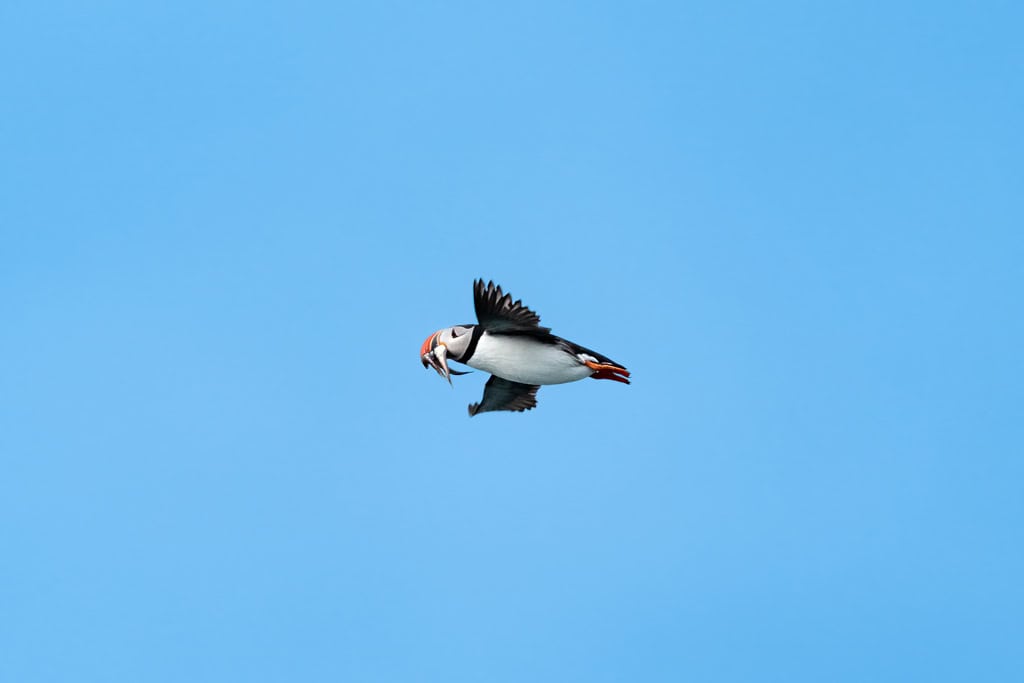
One of the Greg Mortimer’s most innovative features – and something that sets it apart from the Sylvia Earle – are its drop-down hydraulic viewing platforms, located just forward of the bow.
These wings extend out over the ocean, giving passengers a thrilling front-row position just meters above the water.
Our captain dropped the wings during our transit through the pack ice at 82 degrees north in Svalbard, and watching the ice pass underneath us just 750km from the North Pole was simply mesmerising.
The wings are also a gift for photographers, offering unique vantage points that aren’t possible from the main decks.
It’s a feature that perfectly embodies the ship’s philosophy of bringing guests as close to the environment as safely possible.
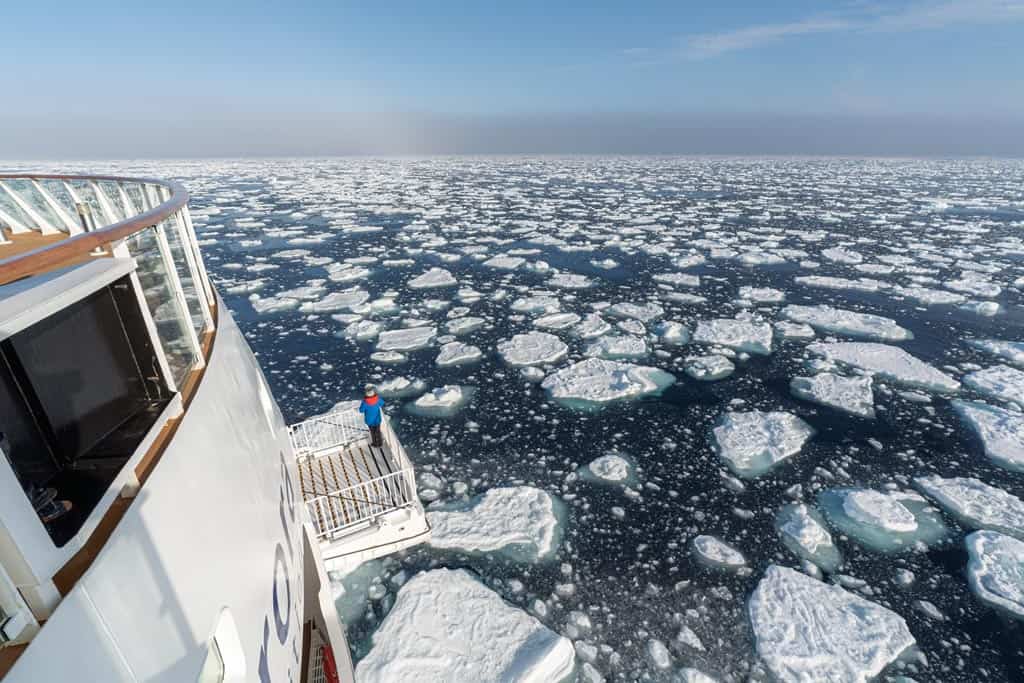
Exploring the polar regions can be surprisingly physical. Days often involve long hikes, clambering in and out of Zodiacs, and hours out in the elements.
The Greg Mortimer balances this adventurous side with a set of wellness and fitness facilities designed to keep guests both active and rejuvenated between landings.
READ MORE: Learn about all of our favourite things to do in Antarctica!
Tucked away on deck 7, the gym is a bright and practical space with everything you need for a solid workout at sea.
Large windows flood the room with natural light and give sweeping ocean views, which helps turn a morning run on the treadmill into something far more inspiring than staring at a blank wall.
The equipment selection is well-rounded: treadmills, stationary bikes, and rowing machines cater to cardio lovers, while a small range of free weights and resistance machines support strength training.
Mats are available for stretching, yoga, or mobility work – a handy option for those who like to loosen up before heading out on landings.
While it isn’t the biggest gym you’ll find at sea, it’s far more comprehensive than many other expedition ships in this class.
Guests who don’t want to lose their fitness routine on a long voyage will find it perfectly suitable.
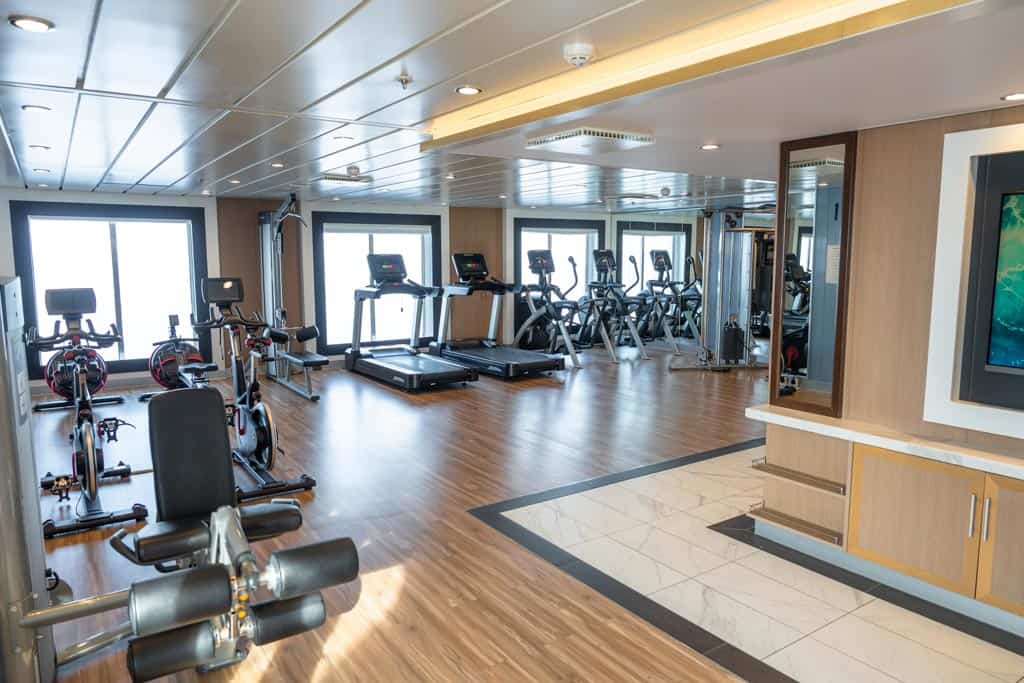
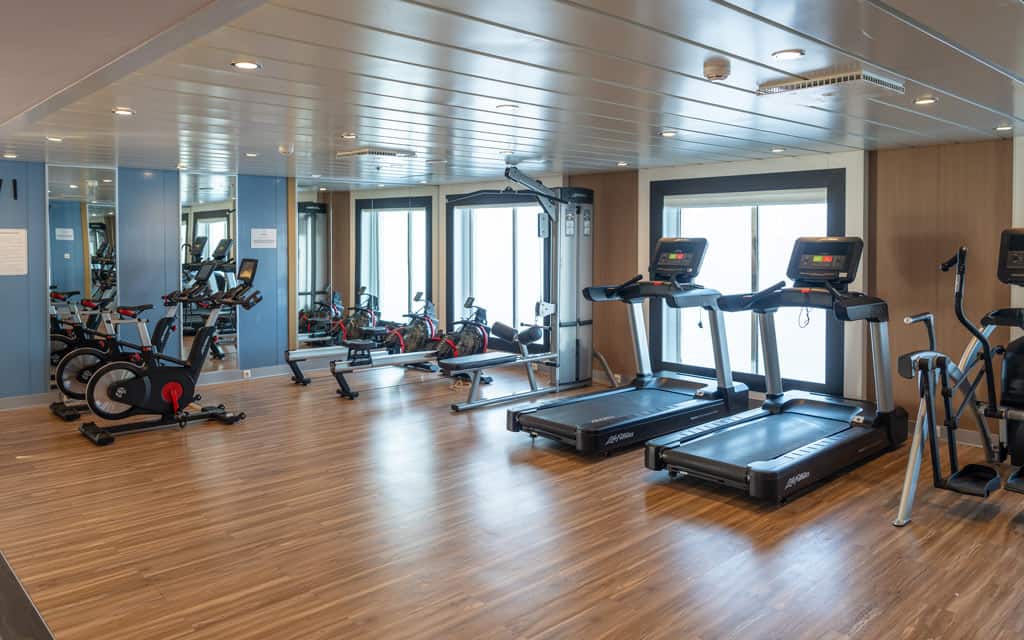
Few things feel better after hours in the snow than stepping into the sauna.
Located near the wellness area, the Greg Mortimer’s sauna offers the perfect post-expedition recovery. The heat soothes tired muscles, helps circulation, and warms you to the core after an icy Zodiac cruise.
The layout here is straightforward rather than luxurious, but it does the job, especially with the vistas you can enjoy., as a large window provides a view outside so you don’t feel cut off from the landscapes you came to see.
The tiny change rooms feel like more of an afterthought than a dedicated space you’d expect with a sauna, but it’s a small inconvenience compared to the beauty of having one onboard at all.
Many guests find themselves lingering here after landings or in the evenings, chatting quietly while the chill melts away.
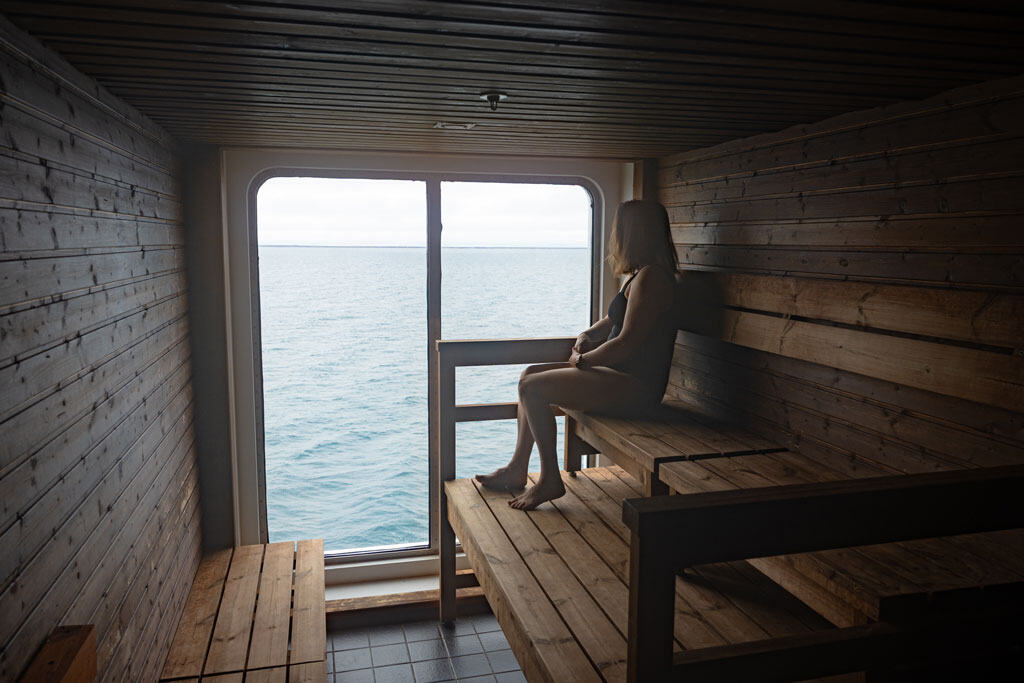
Out on Deck 8 you’ll find two Jacuzzis, which is absolutely decadent (and much appreciated) on those icy Arctic days.
Watching seabirds wheel overhead or spotting whales from a hot tub is one of those surreal travel moments that stays with you forever.
The ship also has a small wellness centre where guests can book treatments such as massages and facials.
Availability is limited, so reservations are recommended early in the voyage.
While not the primary focus of the ship, it’s a nice touch for those who enjoy combining adventure with relaxation.
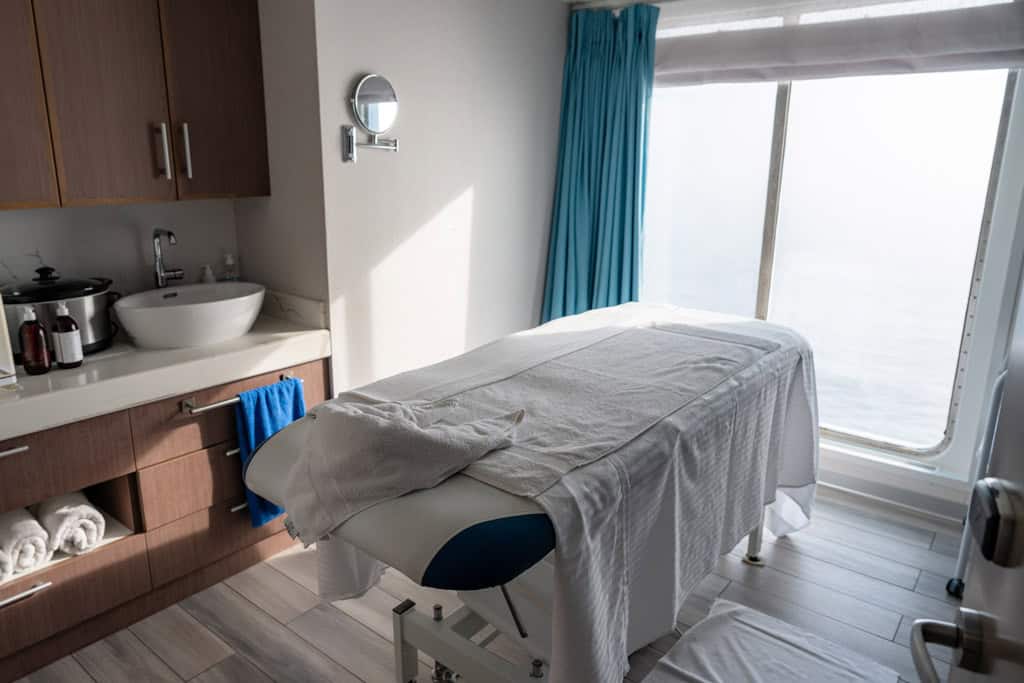
When Aurora Expeditions launched the Greg Mortimer in 2019, it set a new benchmark for what an expedition ship could be.
Purpose-built for exploring some of the most remote and inhospitable corners of the planet, the vessel is packed with design innovations that improve comfort, safety, and sustainability.
The Greg Mortimer was the first passenger ship in the world to be built with the Ulstein X-BOW®, a revolutionary inverted bow design more commonly found on offshore supply vessels.
Instead of riding up and slamming down over waves like a traditional bow, the X-BOW slices cleanly through swells, dramatically reducing vertical motion and hull slamming.
For passengers, this translates into a noticeably smoother experience on notorious crossings like the Drake Passage or during open-ocean transits in the Arctic.
Seasickness is reduced, fuel efficiency is improved, and there’s less strain on the vessel overall.
It’s a game-changing design element that has since been adopted by newer expedition ships, but the Greg Mortimer was the trailblazer.
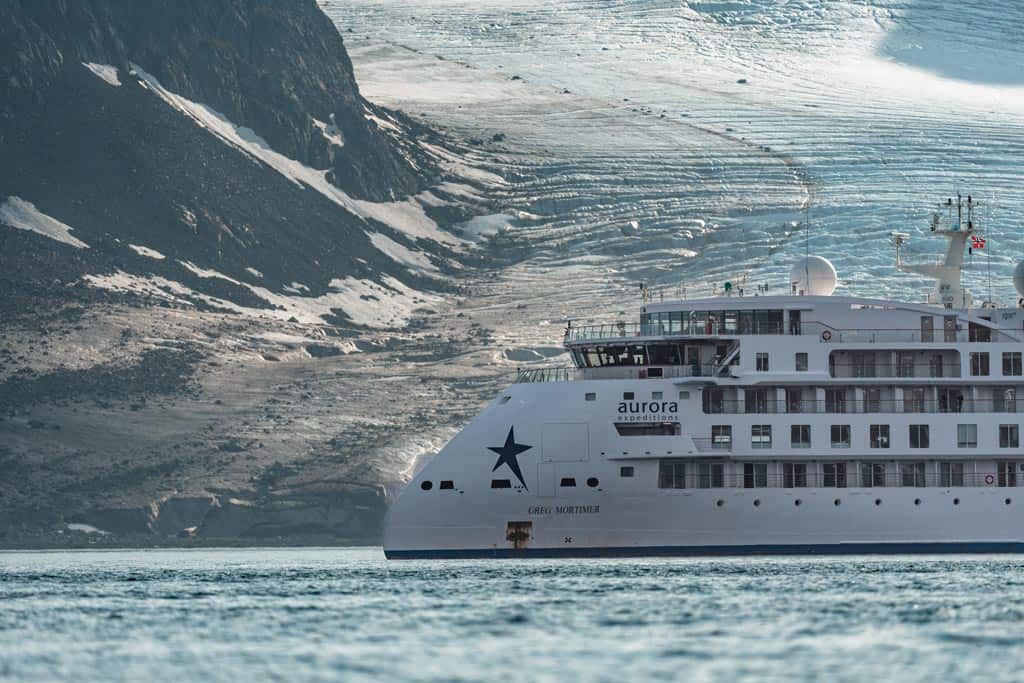
Aurora Expeditions designed the Greg Mortimer with a strong emphasis on environmental responsibility.
Beyond the X-BOW’s improved fuel efficiency, the ship also features a low-energy management system, advanced waste-handling protocols, and dynamic positioning technology that reduces the need for dropping anchor, protecting fragile seabeds.
Single-use plastics are banned onboard, recycling programs are in place, and the expedition team works closely with passengers to ensure strict compliance with IAATO and AECO conservation guidelines.
Every aspect of the Greg Mortimer’s design, from its spacious mudroom to its unique viewing wings, reflects its role as a pioneering expedition vessel.
It was the first of a new generation of small ships built for serious exploration, and while Aurora has since launched the Sylvia Earle and will soon welcome the Douglas Mawson, the Greg Mortimer remains iconic for its bold innovations.
For travellers, these features aren’t just technical details – they directly shape the comfort, efficiency, and intimacy of the expedition experience.
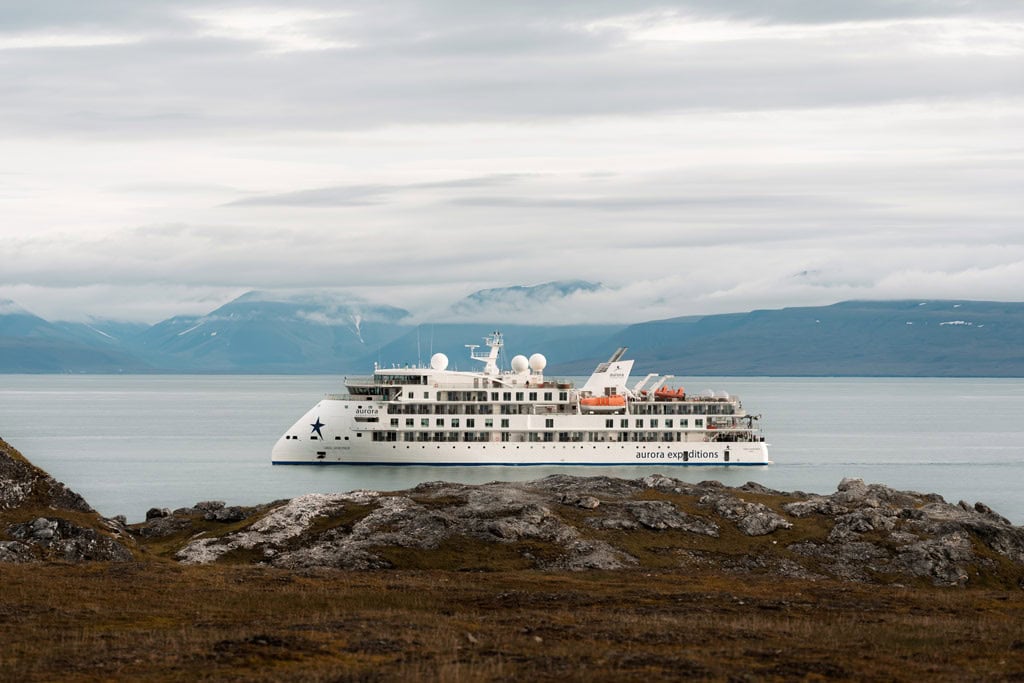
Expedition ships aren’t built for shuffleboard and stage shows – they’re built for adventure.
The Greg Mortimer follows this philosophy perfectly, offering itineraries that take travellers deep into the world’s last great wilderness areas and pairing them with activities that turn a trip into a once-in-a-lifetime experience.
The Greg Mortimer sails on a variety of routes throughout the year, with a strong focus on the polar regions.
- Antarctica – Most voyages begin in Ushuaia, Argentina, and cross the infamous Drake Passage before reaching the Antarctic Peninsula. Longer itineraries combine the peninsula with the Falkland Islands and South Georgia, unlocking some of the richest wildlife experiences on the planet. There’s also the ‘Fly the Drake’ options, where you fly one way between King George Island and Punta Arenas in Chile, sailing back, or sometimes flying both ways.
- South Georgia – During the southern summer some itineraries to Antarctica also visit South Georgia, which is known as the ‘Serengeti of the Southern Ocean’ and one of the planet’s most incredible wildlife destinations. We highly, highly recommend booking a trip that includes South Georgia.
- The Arctic – In the northern summer months the Greg Mortimer heads north, with routes exploring Greenland, Svalbard, Iceland, and the Canadian Arctic. These journeys focus on polar bears, walrus, massive glaciers, and the history of early Arctic exploration.
- Other Destinations – Aurora also operates voyages outside the polar regions, including to Patagonia, the British Isles, and parts of Central America. As of 2026 they will also be exploring the Mediterranean and the South Pacific on their other vessels.
No matter the destination, the focus is always on maximising time off the ship. That means daily landings, Zodiac cruises, and spontaneous diversions whenever wildlife is spotted.
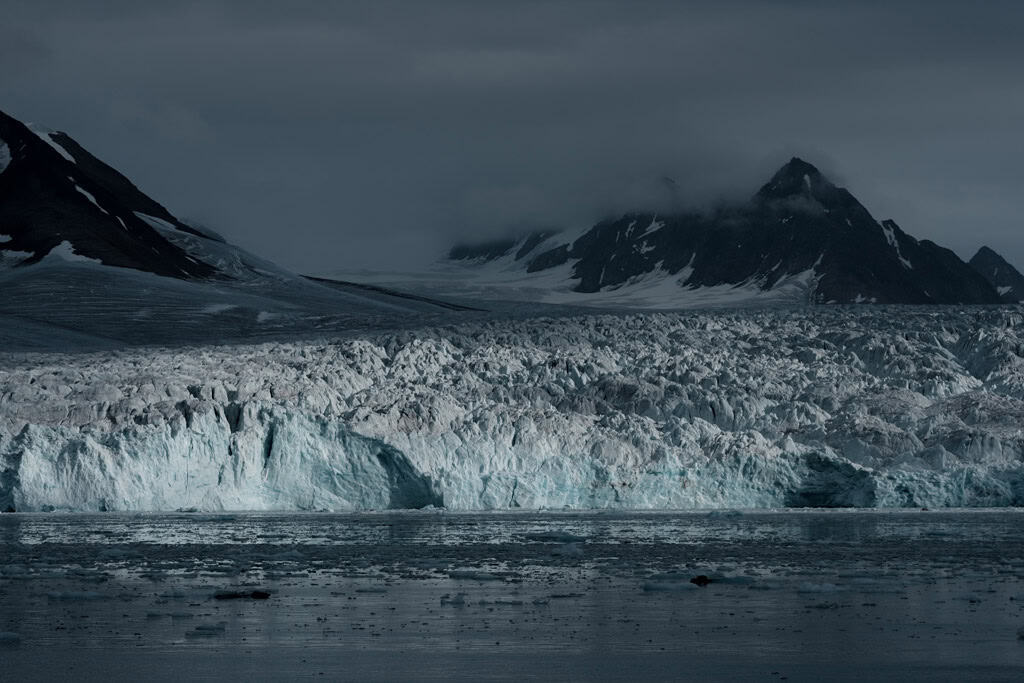
For those who want to push beyond the standard landings, the Greg Mortimer offers a range of optional adventure activities that take the expedition to another level.
- Sea Kayaking – Reserved for small groups of experienced paddlers, this program runs throughout the voyage whenever conditions allow. Paddling past icebergs or quietly floating alongside penguins is one of the most intimate ways to experience the polar regions.
- Day Paddling – A gentler introduction for those who want to try kayaking just once. Using stable sit-on-top kayaks, these outings are perfect for beginners and provide a taste of being on the water without committing to a full program.
- Camping in Antarctica – On certain early-season voyages, guests can spend a night ashore on the ice, bundled into expedition sleeping bags under the stars. There are no tents — just the raw, unforgettable silence of the polar night.
- Polar Snorkelling – With specialist dry suits and expert guides, snorkelling in Antarctica gives travellers a glimpse beneath the surface. It’s cold, yes, but it opens up an entirely different world of ice formations, kelp forests, and curious seals.
Even if you don’t opt into the extra activities, every guest will experience daily Zodiac excursions.
These might be wet landings onto a beach bustling with penguins, or cruises alongside breaching humpbacks and towering icebergs.
The Greg Mortimer’s efficient boarding systems mean groups get off the ship quickly, maximising time where it matters most — out in the wilderness.
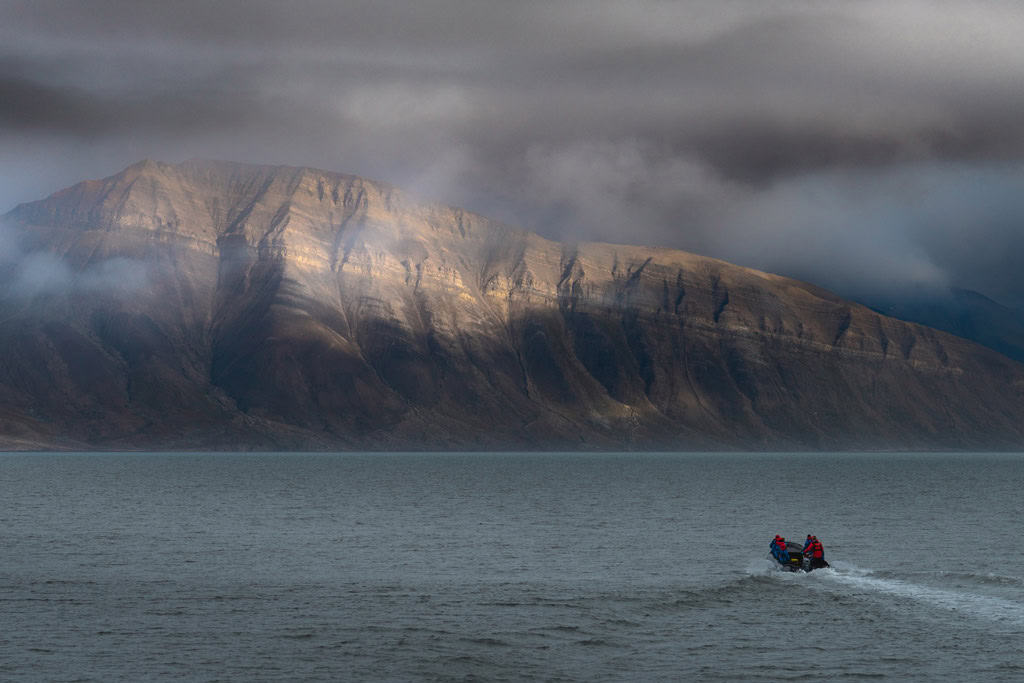
Even with all the design innovations, comfortable cabins, and clever expedition systems, what truly makes a voyage on the Greg Mortimer unforgettable is the people.
The ship’s success rests on the shoulders of its expedition team, hotel staff, and ship crew – each group working together to create a seamless and enriching journey.
At the heart of every expedition is the guiding team.
On the Greg Mortimer, this means naturalists, marine biologists, geologists, historians, ornithologists, and photographers who live and breathe the polar regions.
Their role isn’t just to get you ashore safely – it’s to interpret the landscapes, wildlife, and history in ways that deepen your understanding and appreciation of these fragile environments.
Each day begins and ends with briefings and recaps, where the guides share wildlife sightings, weather updates, and plans for upcoming landings.
During the voyage, they deliver fascinating lectures on everything from penguin courtship behaviour to glaciology, or the incredible survival stories of Shackleton and Scott.
But the real magic happens outside the lecture theatre. Guides are always on deck with binoculars, pointing out whales breaching in the distance, or standing in the snow explaining walrus haul-outs.
Their passion is contagious, and their accessibility, whether chatting over dinner or helping adjust a camera on a Zodiac, makes the expedition feel personal and immersive.
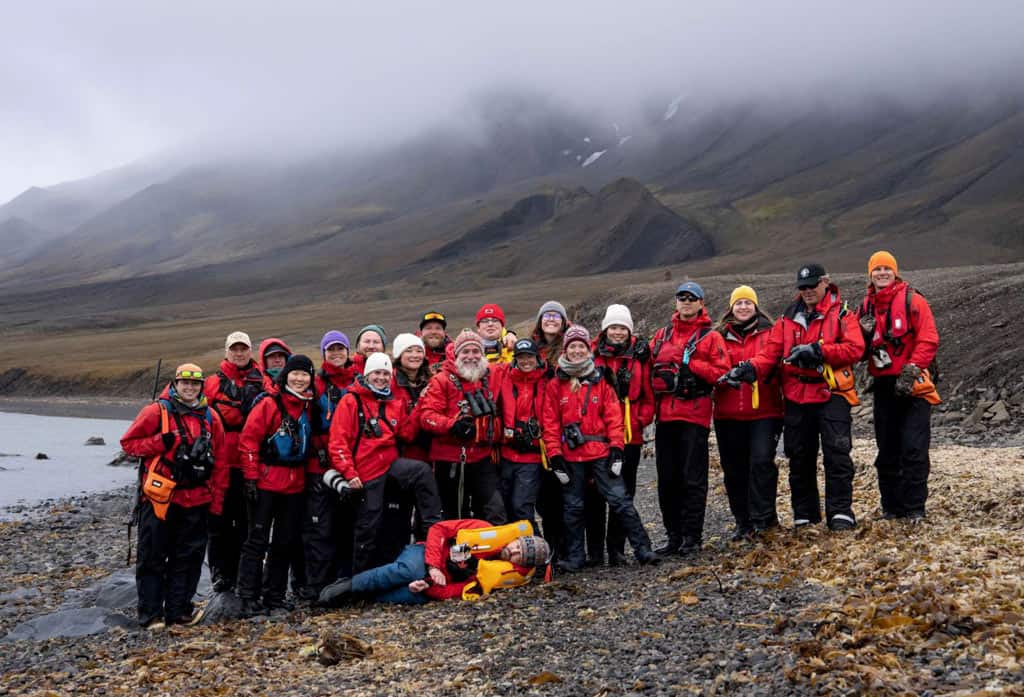
Behind the adventure is a hotel team that makes life at sea feel effortless. The restaurant and bar staff quickly learn passengers’ names and preferences, greeting guests with a smile after a long day in the elements.
They remember dietary needs, pour your favourite drink without asking, and keep spirits high even when the seas get rough.
Cabins are cleaned daily by a housekeeping team that works quietly in the background, ensuring every space feels fresh and welcoming.
It’s the kind of detail that often goes unnoticed until you stop and realise how smooth everything has been running.
The small size of the Greg Mortimer allows for service that feels genuinely personal. By the end of the voyage, the staff don’t feel like strangers working behind the scenes; they feel like part of the journey itself.
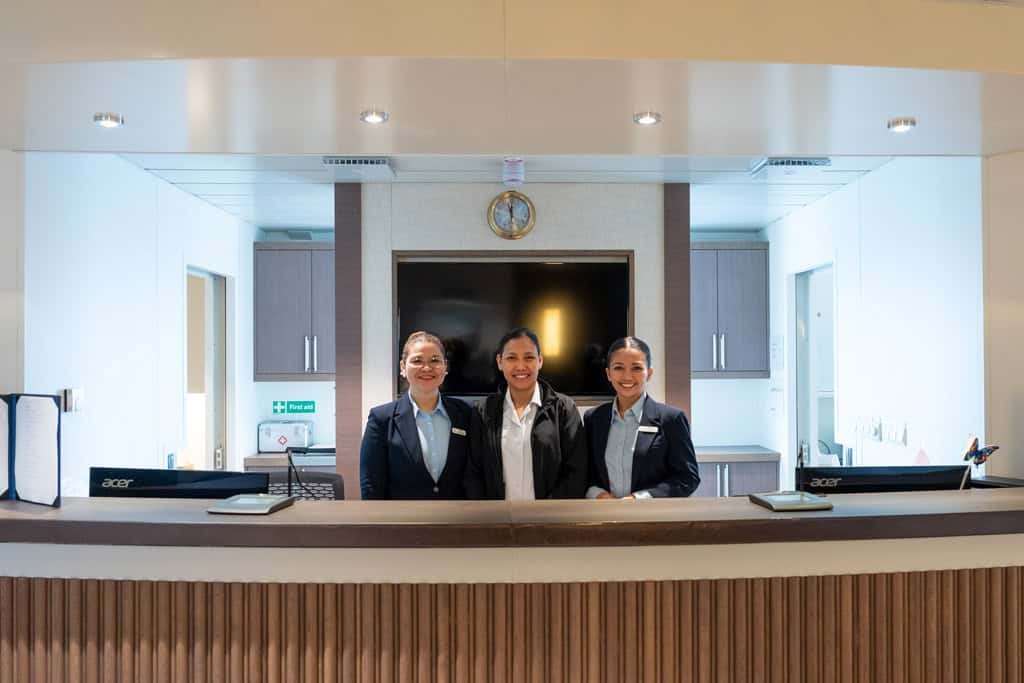
Then there’s the nautical crew, the unsung heroes who keep the ship moving safely through some of the harshest waters on Earth.
From the captain and bridge officers navigating through sea ice to the engineers below deck ensuring the engines hum steadily, their expertise is what makes every expedition possible.
On the Greg Mortimer, the officers are approachable and visible throughout the voyage.
You might see them at dinner, in the lounge, or giving an update from the bridge about ice conditions or whale sightings ahead.
This transparency builds trust and gives passengers a deeper appreciation for the complexity of polar navigation.
Deckhands and engineers are equally essential. They’re the ones rigging boats in all weather, handling lines in icy swells, and ensuring every operation is safe and efficient
Without them, there would be no landings, no kayaking, no smooth days at sea.
Ask anyone who has sailed on the Greg Mortimer what stood out most, and the answer often isn’t the X-BOW or the cabins – it’s the people.
The expedition team, hotel staff, and crew turn a voyage from a checklist of destinations into a living, breathing experience.
They are the bridge between the ship and the wilderness, between the landscapes and the travellers who come to witness them.
For many passengers, the friendships formed with guides, crew, and staff are just as memorable as the wildlife encounters and iceberg-studded views.
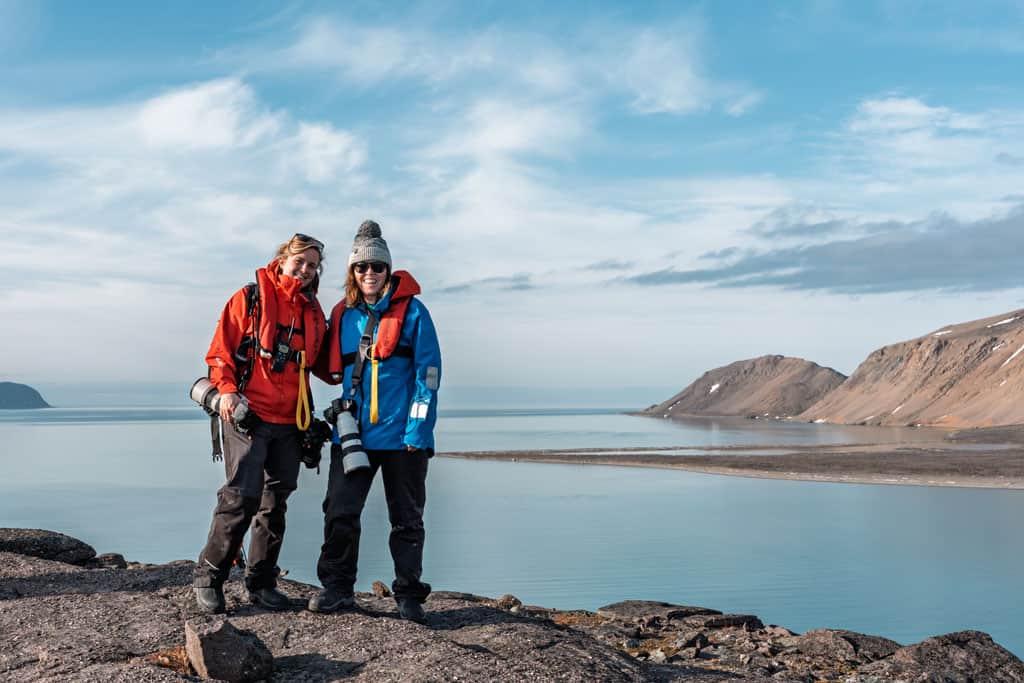
No expedition ship is flawless, and while the Greg Mortimer delivers an excellent overall experience, there are a few areas where adjustments could enhance the journey even further.
These aren’t deal-breakers by any means, but they’re worth noting for travellers weighing up their options.
Unlike her sister ship, the Sylvia Earle, the Greg Mortimer does not feature a dedicated citizen science lab.
While the guides still run science-focused projects and encourage participation in initiatives like cloud monitoring or wildlife surveys, there isn’t a specific onboard space for guests to dive into hands-on research.
For travellers who enjoy the idea of microscopes, plankton samples, and structured lab sessions, this might feel like a gap.
That said, the educational content delivered in lectures, briefings, and informal conversations on deck is still world-class, and many passengers will find it more than enough.
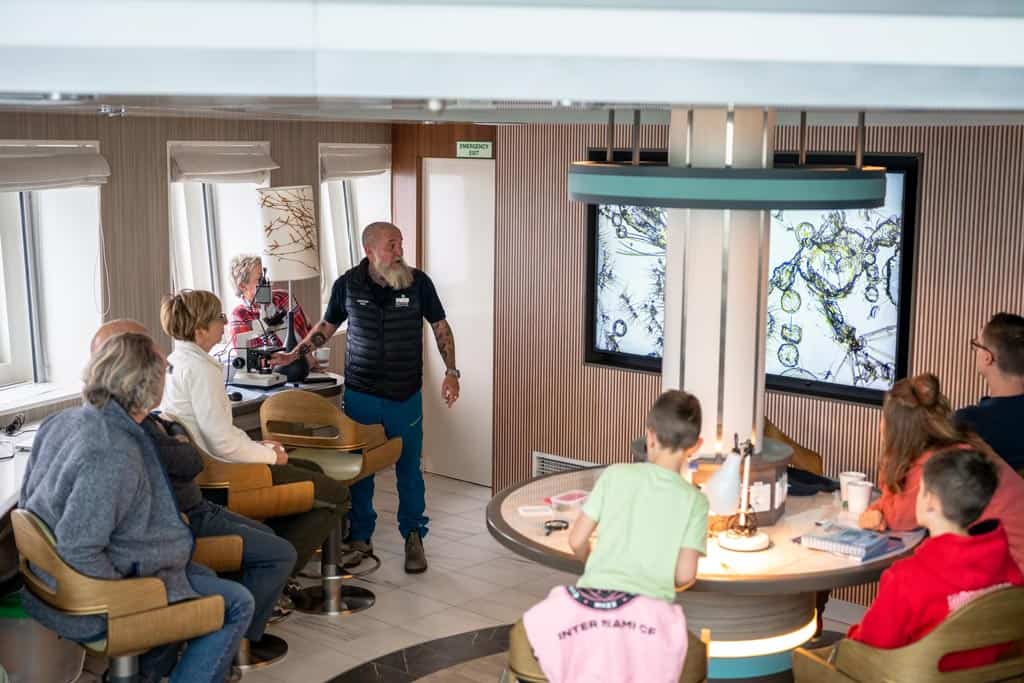
The food quality onboard is consistently high, but some travellers have noted that the second dining venue (the Tuscan Grill) can feel a little limited.
While it’s a nice alternative to the main restaurant and a welcome change of pace, the capacity is small and reservations can fill quickly.
On longer voyages, expanding the menu rotation could add a touch more variety.
The Greg Mortimer isn’t a traditional cruise ship, and it doesn’t try to be.
Still, some guests may find the evenings a little quiet once dinner wraps up.
We talked about this after our Antarctic journey on the Sylvia Earle, but compared to some other operators, Aurora Expeditions doesn’t have much of a focus on evening entertainment.
Aside from the bar scene and occasional bar talks or film screenings, there isn’t much in the way of structured entertainment.
For many, this isn’t an issue – the days are so full that a relaxed drink and early night are welcome.
But for those who prefer a livelier post-dinner atmosphere, even small additions like trivia nights, short cultural talks, or casual music sessions could elevate the social side of the voyage.
The mudroom system is efficient overall, with plenty of space for storing gear and multiple Zodiac loading points.
However, when guests are called down by deck or cabin side, congestion can build up in certain locker areas.
This is a minor operational quirk, but adjusting the system to stagger groups more evenly would make the process even smoother.
These points are small in the bigger picture, and none of them overshadow the strengths of the Greg Mortimer.
But Aurora Expeditions has a reputation for innovation, and small tweaks like these would push the onboard experience closer to perfect.
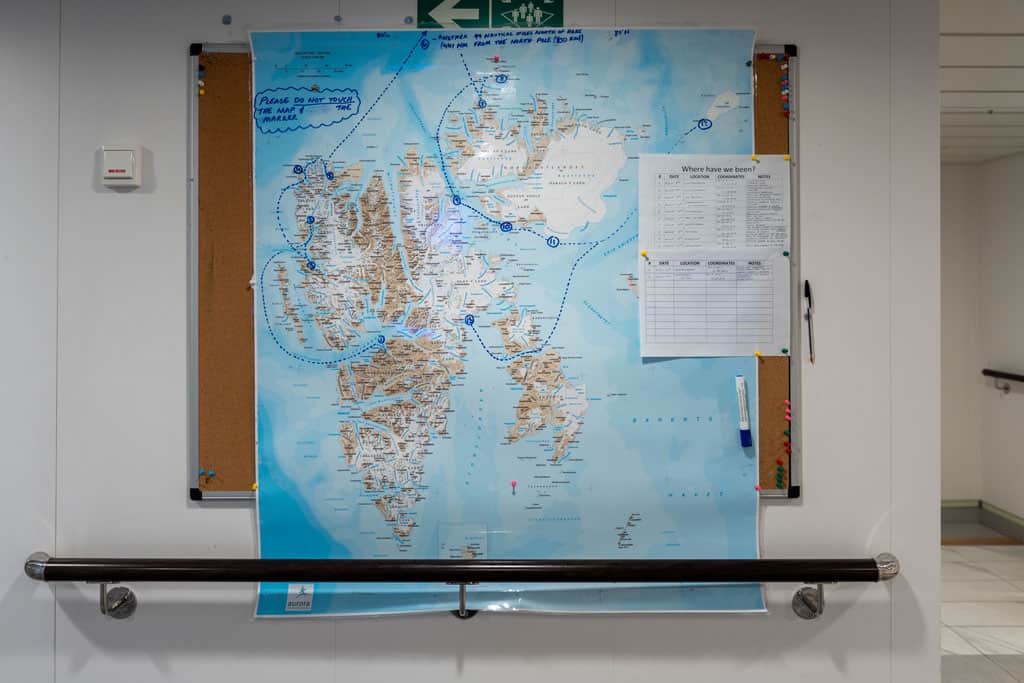
We hope you found our Greg Mortimer ship review useful!
The Greg Mortimer set a new benchmark when she launched in 2019, and even today she remains one of the most capable and comfortable ships sailing in the polar regions.
Purpose-built for expedition cruising, she combines smart design – like the pioneering Ulstein X-BOW and fold-down viewing platforms – with a small passenger capacity that ensures every guest gets the most out of each landing.
Life onboard is easy and engaging. The ship feels spacious without losing its intimate, expedition-focused atmosphere, and the expedition team are outstanding at turning every outing into a meaningful learning experience.
The hotel staff and crew deliver warm, attentive service that never feels forced, and the Zodiac operations run like clockwork.
The Verdict: If you’re looking for a modern, comfortable, and expertly run ship to explore Antarctica, South Georgia, or the Arctic, the Greg Mortimer is an excellent choice.
She’s innovative, well-equipped, and passenger-focused, delivering a memorable balance of adventure and comfort.
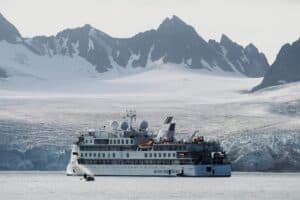
Curious about Aurora Expeditions’ first X-BOW vessel? In our Greg Mortimer ship review we reveal the highlights, quirks & adventures from onboard.
Product Brand: Aurora Expeditions
- X-BOW design
- High-end dining options
- Industry-leading expedition team
- Efficient and safe operations
- Sustainable company and design
- No citizen science lab
- Sauna and spa could be better
nomadasaurus





